40 best instructional design software tools

Self-paced training and learning programs are a great way for organizations to upskill their teams and create innovation. The right instructional design software can be the difference between an engaging learning experience and a training program that falls flat. So how to choose the right solution for your needs?
In this guide, we'll explore instructional design software tools that help learning designers at every stage of the process. From creating a learning flow and conduct needs assessments all the way through to creating training videos, hosting your courses and measuring the impact, you'll find a tool to help here.
Innovative organizations full of happy and productive employees often have one thing in common: opportunities for their team to develop new skills and grow in their careers.
As LinkedIn’s 2023 learning report noted, 89% of L&D professionals agree that building employee skills will help organizations navigate the evolving future of work. 94% of employees are likely to stay at a company longer if there is an investment in the their development.
Learning and development programs, training sessions and elearning courses are all popular ways to help upskill teams, but how are they made? What instructional design software exists to help an instructional designer or learning team create effective materials, source input and evaluate the impact?
Read on to discover software to help you streamline your workflow and build more impactful materials at each stage of the instructional design process.
What is instructional design software?
Instructional design software includes a host of specialized tools designed to facilitate the development and distribution of learning content and materials. These tools can range from content authoring tools and video editing software all the way through to learning management systems and interactive learning platforms.
Depending on the needs of the training or learning process at hand, you may need one or multiple instructional design tools in order to create, organize and deliver the most effective learning programs for your teams and clients.
I find it easiest to first consider the entire instructional design process and see where tools might be deployed to streamline processes and facilitate the work of a learning team.
Starting with design, instructional designers first need tools to help them map out an effective learning flow and ensure their program will help meet training goals. Pen and paper might work for some designers, but learning design tools like SessionLab can help you create and organize complex learning programs with ease.
Once a solid learning plan has been drafted, instructional designers need to turn that plan into content that will engage learners. This can include creating training videos, software simulations, interactive games or simply enriching written training content with images and interactive elements such as quizzes.
For self-serve courses and learning programs, you’ll also need somewhere to host the materials so trainees can access them and so you can track learning progress. In the case of trainer-led or blended learning programs, you’ll likely employ additional tools to help support the trainer during delivery and to make that training more engaging for participants too.
At every stage, instructional designers will likely need to source material from subject matter experts and collaborate on copy. They’ll also need a place to store files, collect copy and training materials and project manage a process with many moving parts.
In this guide, we’ll categorize instructional design software by its role in the instructional design process so you can find the right tool for your needs. On-site training has a different set of needs than on-demand learning programs and your choice of instructional design software tools will naturally reflect this.
The different types of instructional design software are:
Storyboarding software
After you’ve conducted your training needs assessment and outlined your instructional design project, the next step is to storyboard your learning solution.
Content authoring tools are great for packaging together multimedia, text, links and more into a format you can then feed into your LMS. But for many learning designers, there’s a crucial step before this that requires a different solution.
Instructional design professionals often use a storyboarding tool to design their learning flow, sequence and re-sequence activities and create an effective design document they pass onto stakeholders or developers to implement. This document, we call a storyboard.
A well designed storyboard is a blueprint that enables the effective creation of your eLearning project. By storyboarding, you’ll be able to save time in the creation process and ensure that you’ve created a course design that will achieve learning goals and business objectives.
Typically, your eLearning storyboard will be the place where you collect materials from subject matter experts, design your learning experience and turn an outline into a complete course design. Once that’s done, you’ll then get approval on your design and either begin creating the course in an content authoring tool or LMS, or pass it to developers to implement.
SessionLab
SessionLab is an effective tool for creating instructional design storyboards. Here, there’s an emphasis on crafting an effective learning flow, saving time in your workflow and making it easy to collaborate effectively with SMEs and developers. Here’s how.
Drag and drop blocks for each slide of your eLearning course to quickly structure your learning flow. Customize blocks to include voiceover, on-screen text, animations and whatever other information you need..
Add text highlighting and colours to easily overview storyboard elements and make it easy for you and your developers to overview and implement.
Need help designing an ideal learning flow? See your entire course flow in one-screen and colour code blocks by activity type to create a balanced learning experience.
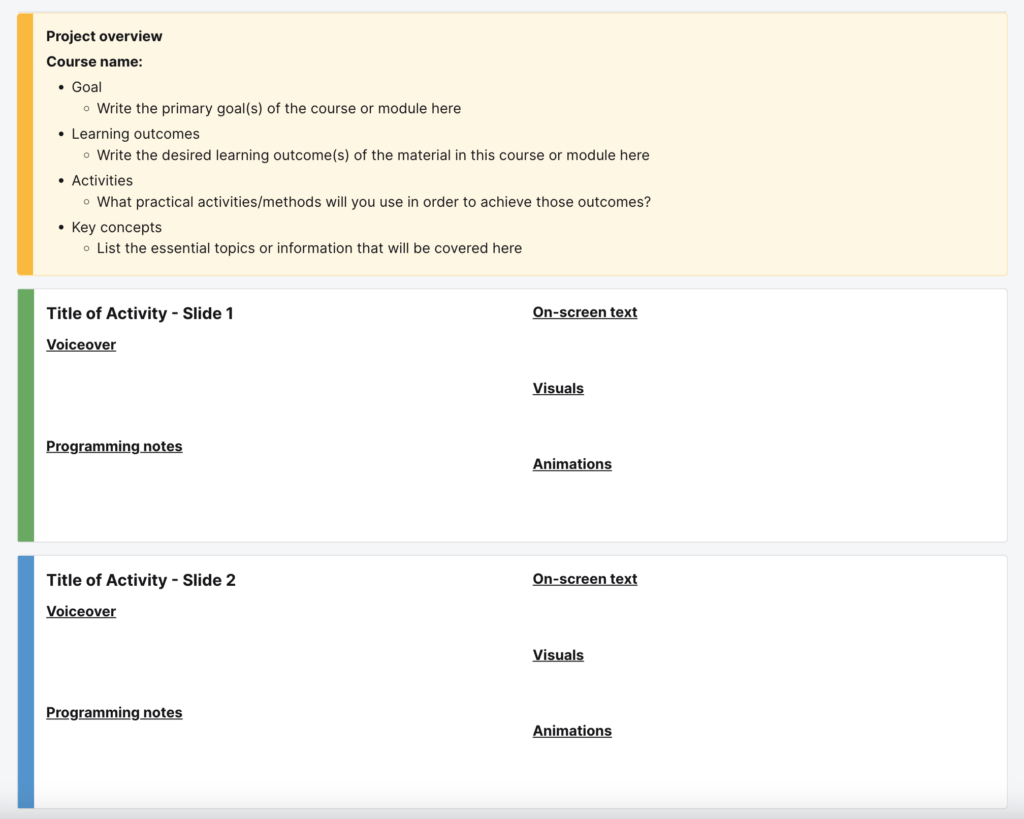
With SessionLab, it’s easy to create a single source of truth for your course design and update it with easy. Add attachments, research, media files and links to individual slides. Invite subject matter experts, content creators and instructional designers to collaborate in real-time or leave comments and complete your course design asynchronously.
Once your storyboard has been approved, export your instructional design materials in the format that works for you. Using an LMS? Invite your team to your session or export your material to clipboard, Word, Powerpoint or PDF.
Save time on your next project by turning a proven storyboard or course design into a reusable template. Create a knowledge base of all your best storyboard templates and course designs and share it with your team.
Also delivering materials for a face-to-face training program? Easily create a beautiful, customized run-sheet with clear instructions and timings to make your training design easy to follow and deliver. Easily convert your storyboards into ILT sessions and remix your materials as you choose.
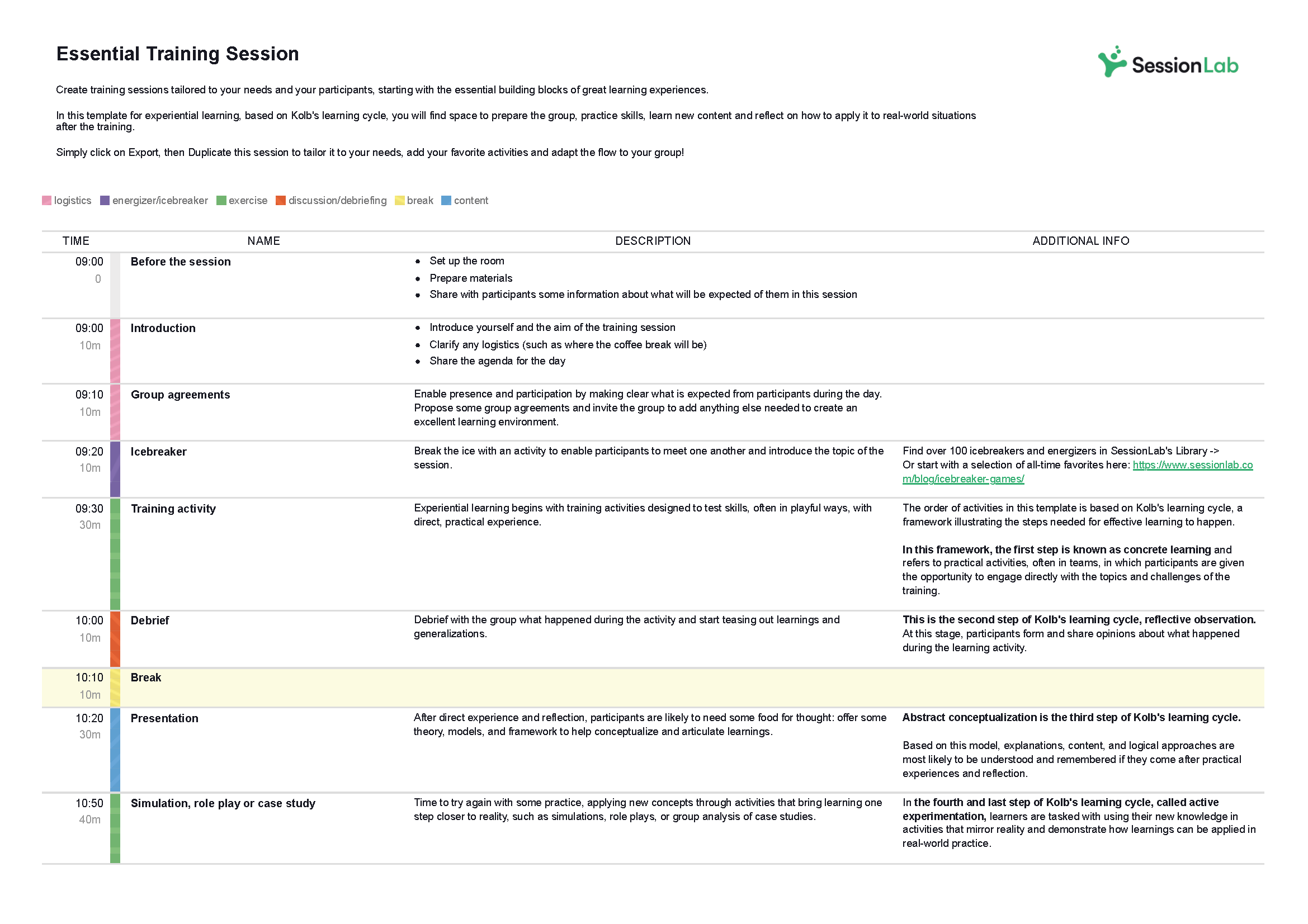
SessionLab cost
SessionLab has a free forever plan. Paid plans including features like unlimited sessions, real-time collaboration and a team content library start at $15 per month.
PowerPoint for storyboarding
It’s impossible to talk about elearning storyboarding without talking about PowerPoint. It’s used by many instructional designers as it is easy to use, is integrated with Microsoft Teams and gets the job done.
Whether you’re creating a visual or written storyboard, PowerPoint is a simple and effective way of making a low-fidelity storyboard. It particularly shines when creating a visual storyboard containing images and placeholder buttons – creating mock-ups is a bit hacky, but it’s fast!
For me, PowerPoint falls down when it comes to actually designing an effective learning flow. It’s not designed for creating effective learning experiences, and so it’s missing some features that enable good course design practices and simplify the process.
PowerPoint cost
PowerPoint is included in Microsoft 365 suite starting at $6.99 a month. You can also make a one-time purchase for $159.99.
Articulate Storyline 360
Included on many an instructional designer’s CV, Articulate Storyline is the big name in content authoring and it’s a great tool for storyboarding too. Storyline is a powerful tool designed for creating eLearning for desktop and laptop based eLearning. It looks a lot like PowerPoint on first look, though it has lots of features under the hood to create triggers, simulations, quizzes and advanced interactivity.
Storyline can be tough to learn for newcomers, and for the purposes of storyboarding, many instructional designers choose a simpler option, like Docs, PowerPoint or SessionLab, as its much easier to focus on designing a good learning flow before moving into content creation. It does slightly fall down for having only a Windows version, but for teams who are primarily look for a content authoring tool with some storyboarding capabilities, Storyline 360 is hard to beat.
Articulate Storyline 360 cost
Articulate Storyline is included in the Articulate 360 suite, starting at $1,099 per user, annually and $1399 for teams.
Once you’ve designed an ideal learning flow and sourced supplementary materials, you’ll need to package everything together into an attractive, engaging course. Content authoring platforms are tools designed to help you get self-paced, asynchronous courses and training into a format that’s ready to share and host elsewhere.
In these tools, you’ll often bring your learning flow to life with images, video content, interactive quizzes and more. These tools typically integrate with learning management systems and make it easy for instructional designers and multimedia teams to turn their content into a visually appealing and engaging course.
Articulate Rise 360
While Articulate Storyline 360 is geared straddles the gap between storyboarding and content authoring, Rise 360 is more squarely a content authoring tool. It has an emphasis on using pre-built content in a simple interface to create eLearning that looks good on any device, including mobile. It’s easier to learn and use than Storyline, but the trade off is in flexibility and power.
As part of the Articulate 360 suite, Rise is especially effective at creating interactive and responsive courses that you can plug right into your LMS. It has a heap of templates and visual content you can use to augment your course design. For simpler projects with less complex interactivity or for less experienced instructional designers, Rise is often considered a good alternative to Storyline. You can often move faster and create good material with less effort than Storyline though a lack of customization can sometimes mean that you’ll need to use a different tool dependant on the format or needs of your course.
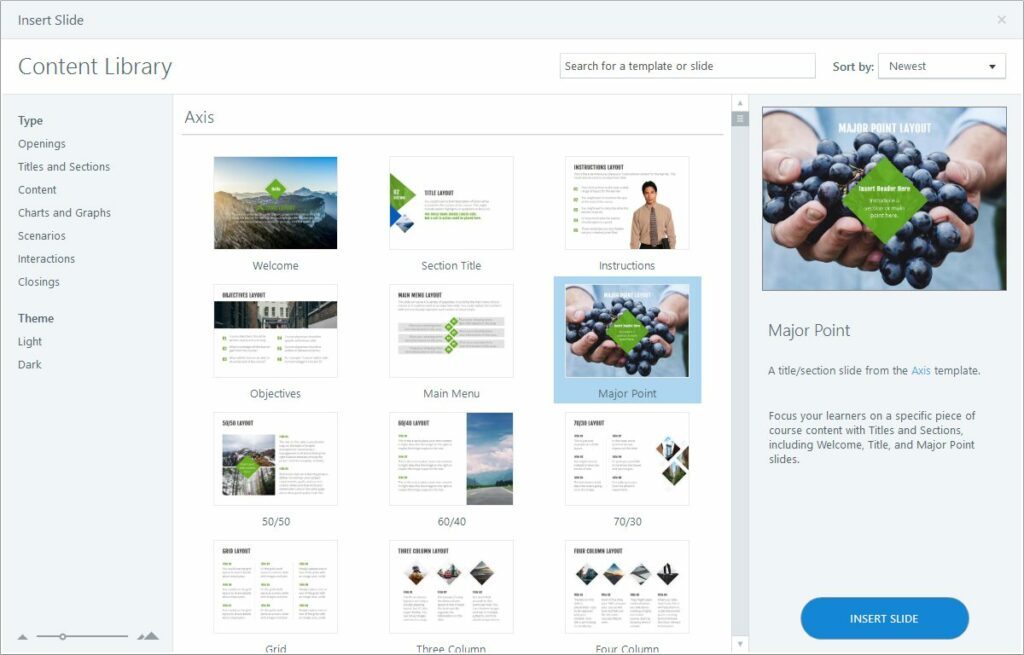
Articulate Rise 360 Cost
Articulate 360 has various plans for freelancers, companies and academic institutions. Plans for freelancers start at $1,099 per user, annually and $1399 for teams.
Elucidat
Elucidat is a content authoring platform that prioritizes collaborative instructional design in the cloud. Its intuitive interface and drag-and-drop functionality make it easy for teams to create responsive and visually appealing e-learning content that works on many devices.
Elucidat’s analytics tools also provide valuable insights into learner engagement and performance, enabling designers to refine and optimize their content based on real-time data. Designed for Enterprises and L&D teams operating at scale, it’s a good choice for large teams who need robust tools, though its cost is similarly large.
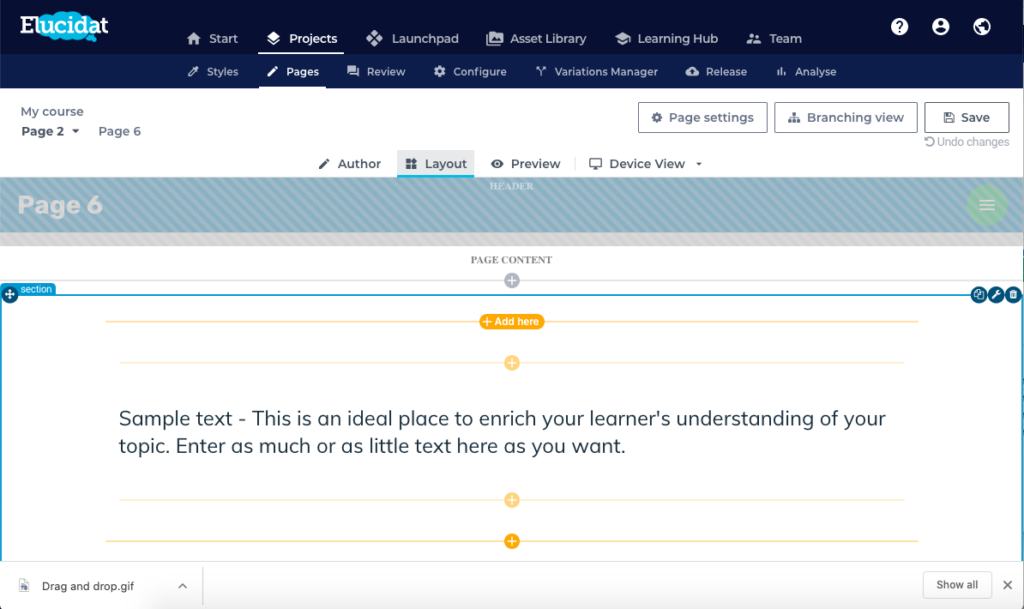
Elucidat cost
Custom quote.
Adobe Captivate
Adobe Captivate stands out as a versatile content authoring platform with a focus on creating immersive and interactive learning experiences. With features like virtual reality (VR) capabilities and smart learning interactions, Adobe Captivate empowers instructional designers to go beyond traditional e-learning.
The platform’s responsive design and multimedia capabilities make it an excellent choice for creating engaging content that resonates with learners, especially if your media teams are already invested in the Adobe suite.
You’ll find a heap of templates and ready-to-go slides and a cost that is far more accessible to freelancers and consultants. If you’re a learning designer working with small teams or who doesn’t have a large budget or existing team for multimedia design, Adobe Captivate is a great choice.
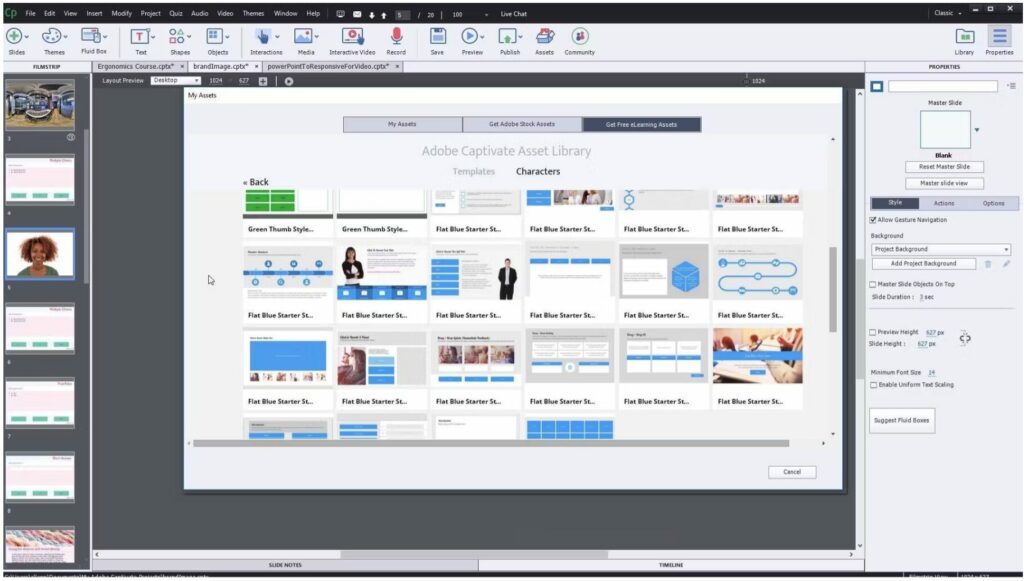
Adobe Captivate cost
Adobe Captivate pricing starts at $33.99 per month for individual users and includes a 30-day free trial.
iSpring Suite
iSping Suite is simple yet powerful instructional design software that will be immediately familiar to anyone creating powerpoint presentations. It’s a great content authoring tool for instructional design that helps you easily create courses, interactive presentations, assessments, video training and more.
An experienced instructional designer will find robust features here, though you’ll find a learning curve that will you help you quickly create great training courses even as a newbie. It’s easy to export to SCORM and we also loved the ability to create ebooks with attractive flipbook effects to help engage learners. You’ll also find a content library to help you create professional instructional materials at speed.
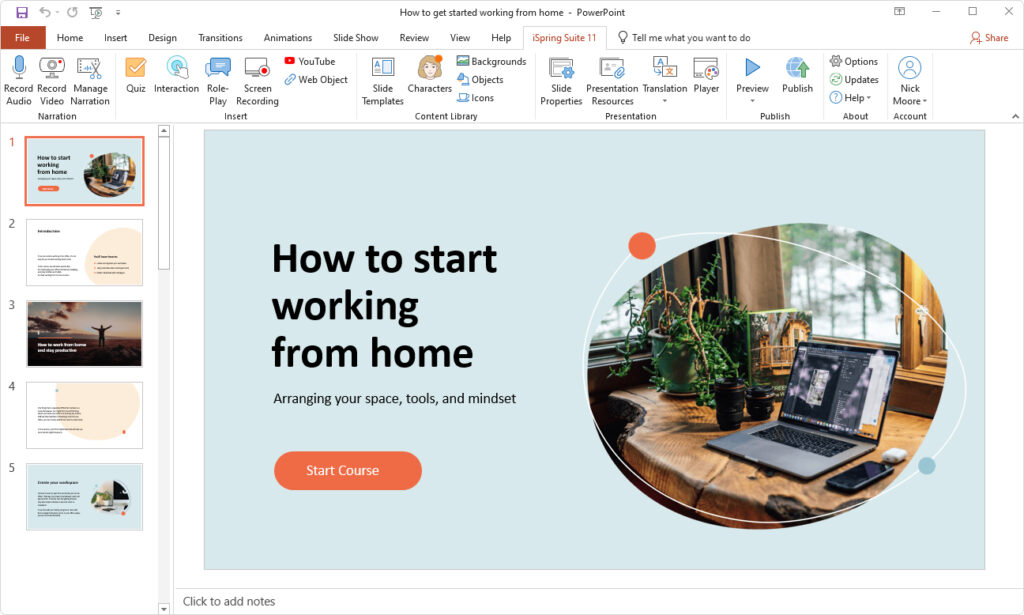
iSpring Suite cost
iSpring Suite plans start at $770 per user per month.
Video recording and editing software
Most self-paced training courses and learning materials include video content of some kind. Instructional designers might typically create video demonstrations of tools and processes or include presentations of learning material to better engage learners and add variation to a training program. The tools collected below are designed to help instructional designers create, edit and share videos to use in their training materials.
Depending on your course and needs, your choice of video tool might vary. Simple screen recording software such as Loom can be sufficient when creating supplementary video materials. On the other hand, if your course is primarily delivered via video, you may want a tool that makes it easy to create and edit professional content to a high standard or house style.
Determine the needs of your learners and your training flow when choosing a video tool – professional video content is important but a screenshare of a PowerPoint presentation or a walkthrough of a tool can be just as impactful as a custom animation. It’s also easy to get carried away and spend forever creating beautiful videos that never get watched. Match your tool to the scope of your training so you can be efficient and effective when creating your materials.
Loom
Loom is a versatile screen recording and video creation platform that doubles as a valuable content authoring tool, especially for learning designers helping teams learn new tools. At SessionLab, Loom has become a valuable knowledge transfer tool by making it easy to quickly record and present items to other team members. We’ll often embed a Loom right into our Notion pages or learning platforms.
For learning designers who need lightweight video materials and screen recordings to support their training and internal processes, it’s an easy-to-use tool that can easily find a place in your toolkit. We especially love the AI-powered transcription and summary taking features – it really speeds up the process of creating materials anyone on the team can access.
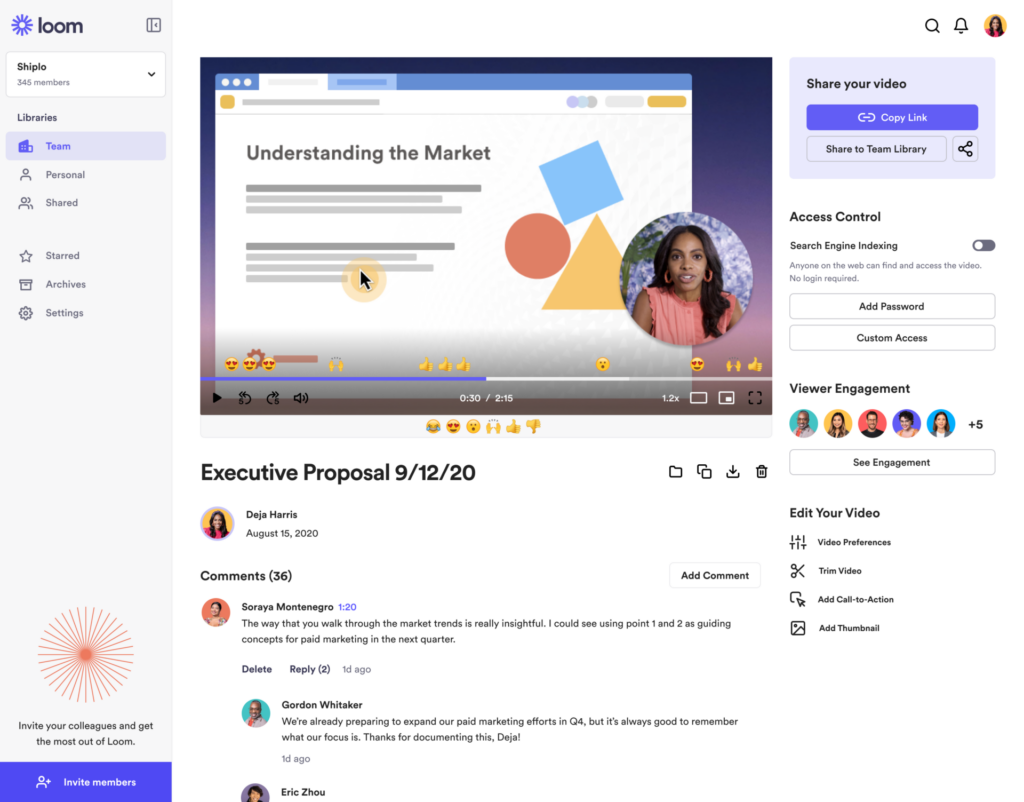
Loom cost
Loom has a free plan for getting started and has a business plan starting at $12.50 per user per month.
Camtasia
Camtasia is powerful yet easy to use software for editing video content that allows content creators to elevate their materials with effects, transitions and other assets.
For advanced instructional designers seeking to create engaging videos that can form the core part of their training, Camtasia is a worthwhile investment. Many reviewers mention that the tool is easy to use and teach others and with a simple drag and drop interface, it can make the process of scaling video creation quick and easy.
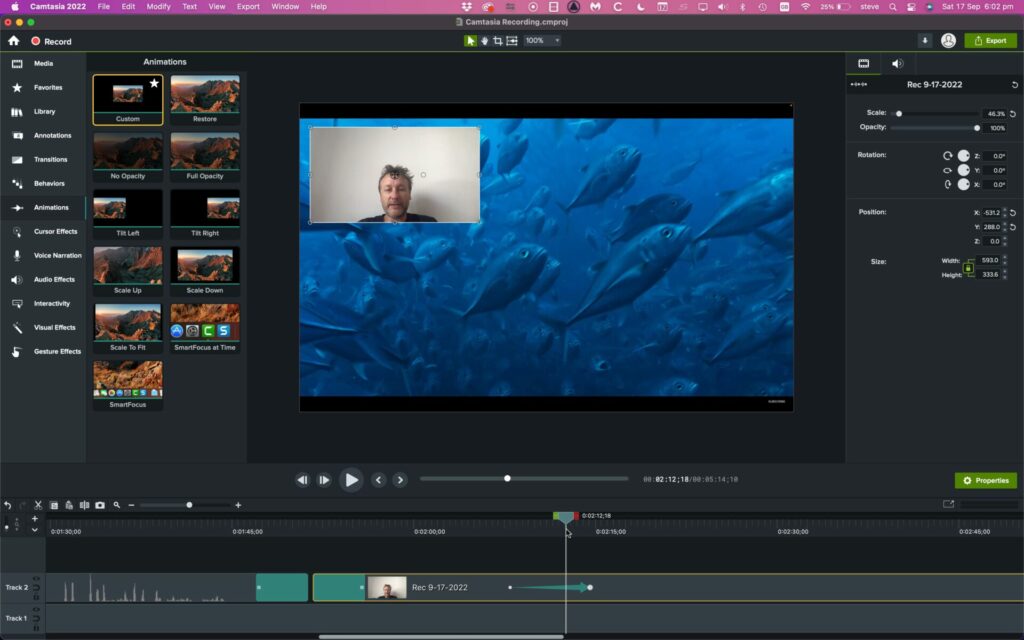
Camtasia cost
Camtasia plans start at $179.88 for a yearly subscription or $299 for a perpetual subscription.
Movavi Video Suite Business
For instructional designers who want the most professional and attractive looking video content in their courses, Movavi provides a powerful suite of tools that can also speed up the creation process.
Movavi has helpful features for everything from simple screen recording to support for video conferences, webinars and more. Incorporating text, voiceovers and effects into your video content is easy, and it also supports the use of AI upscaling, motion tracking and advanced export features to ensure your videos are the best we can be.
We loved that Movavi has various versions based on your needs, so you don’t need to buy-into a complex suite if all you need is simple video editing.
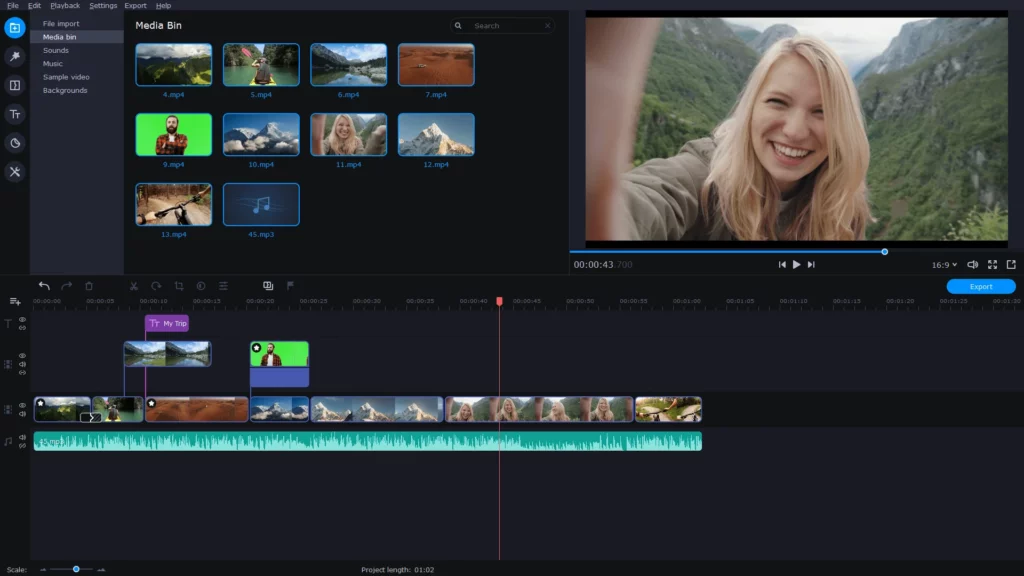
Movavi cost
Movavi features a whole suite of tools that can be purchased individually or as part of a bundle. As of writing, Movavi’s Video Suite Business subscription starts at $309.95. That said, their plans are often discounted and you can contact their Sales team for bulk discounts too.
Webinar and video chat software
In addition to developing self-paced courses, many instructional designers create materials to deliver directly to learners in training sessions and workshops. In an increasingly remote and hybrid working environment, it’s vital for trainers to have powerful software for delivering training webinars and virtual sessions. These tools are great for any trainers and learning designers who need to deliver material to learners in a live environment.
Beyond standard features like screen sharing and recording, the best webinar software also includes features to help create learning engagement, such as polls, quizzes and integrations with online whiteboards and collaboration tools.
When choosing your video chat tool, always consider the needs and proficiencies of your target audience. Simple tools that they already use might be better than introducing something new with all the bells and whistles. Think about the ideal learning experience for your trainees and pick a tool that best supports those goals.
Zoom
Zoom has become a go-to video conferencing tool for many teams and instructional designers. It includes most of the features you’ll need when hosting webinars and virtual training such as screensharing, recording and simple engagement tools. Because so many people are familiar with it, it’s easy to get on with leading your sessions, rather than needing to teach people how to use it.
The only caveat is for instructional designers who might be hosting courses for members of the public. Managing attendees and payments before a session and understanding audience drop-off isn’t easy in Zoom, and you might find another tool better serves your needs. That said, for internal L&D teams and consultants delivering training to a single client, Zoom is a solid, dependable choice of instructional design software.
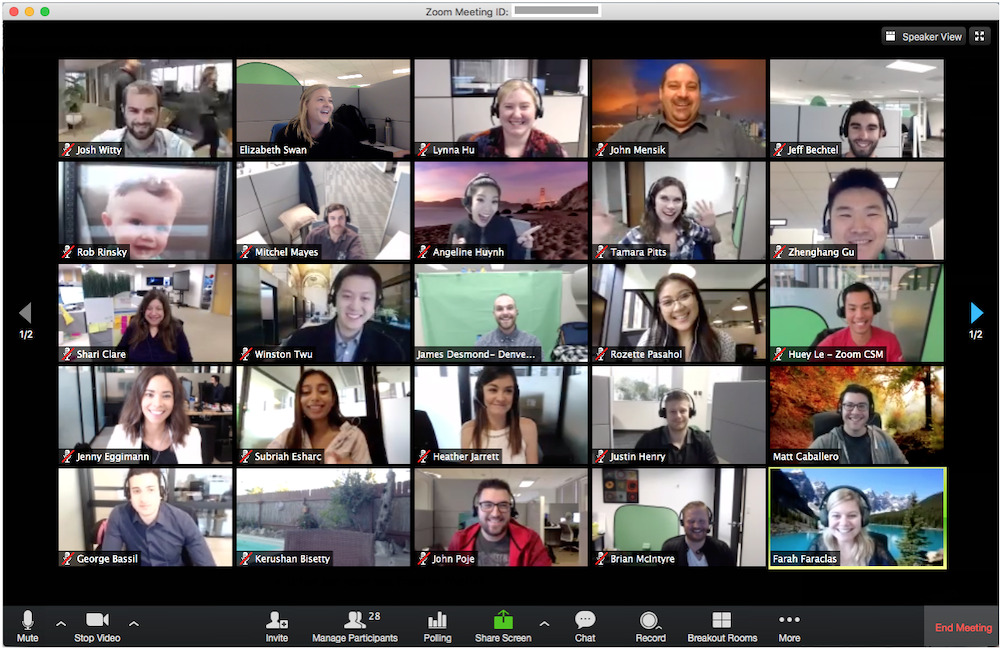
Zoom cost
Zoom has a limited free plan and paid plans starting at $14.99 per host, per month. Note that for hosting webinars and bigger events, you may need to upgrade to one of their more advanced plans.
Big Marker
Big Marker is a great tool for creating virtual events and webinars. For trainers and educators who may wish to incorporate live sessions into their training programs or need to manage attendees effectively, Big Marker is a great choice. You’ll find all the core features you expect from video conferencing software such as event chat, polls, Q&As and handouts. You’ll also be able to host your recordings in a learning hub for participants to access in the future.
Big Marker takes a little time to learn, but the pay-off is a powerful tool that can easily service the needs of trainers running events with ticketing and sponsor needs. It’s also great for internal teams whose cohort based learning programs have a mix of live events and recorded material.
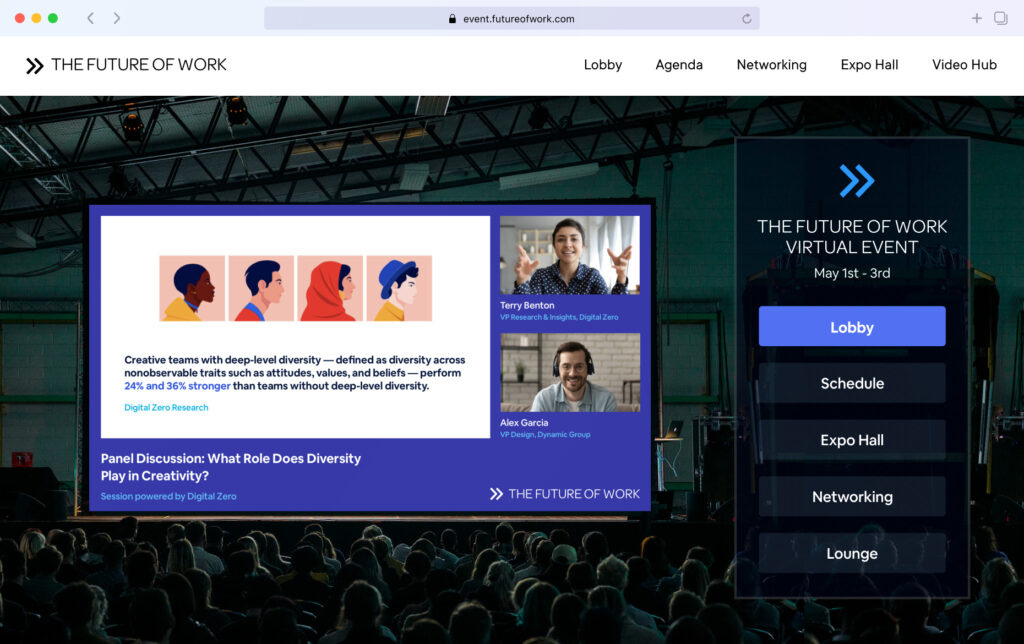
Big Marker Cost
Big Marker offers various plans you can tailor based on whether you’re creating live webinars, ticketed events, learning hubs, or all three. Contact them for a custom quote.
SpatialChat
In real life, trainers and facilitators are able to create spaces that can be conducive to learning and can help create connections between learners. When running virtual training sessions, this can be a little trickier. SpatialChat is a video conferencing tool that works spatially, so participants can move around, talk to people close to them and even navigate a virtual office or event space.
In SpatialChat, you’re able to customize your virtual space, run presentations, send people into breakouts and simulate some of the magic of an in-person event. Leave up artifacts created by your trainees in the virtual space and share Google Docs and Miro boards without leaving the virtual classroom.
For cohort-based learning where conversations and activities between trainees are fundamental to your learning design, SpatialChat is well worth your consideration.
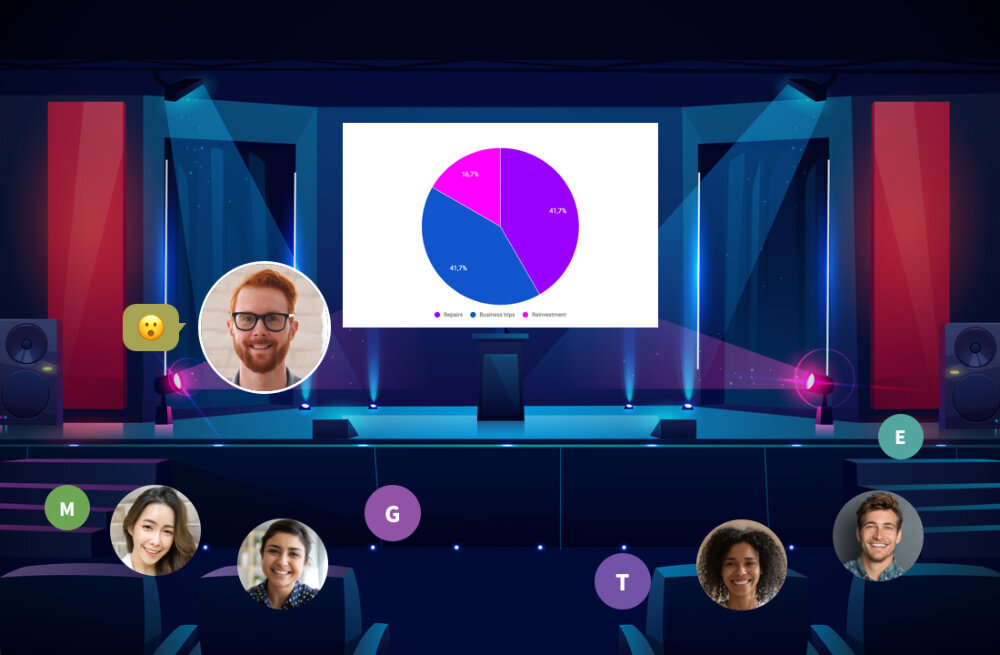
SpatialChat Cost
SpatialChat has a free plan to help you get started, though for instructional designers running ongoing training and a need for a virtual space, you’ll likely want to check out their paid plans, starting at $3.50 per user, per month.
Survey tools
At various points in your instructional design process, you’ll need to gather input from trainees, staff and clients. You may source input for a training needs assessment before creating your instructional design. You might also survey trainees during your training program or in a virtual training session to support your training content. Once you’ve delivered the training, it’s also a great idea to collect feedback so you
While your LMS or content authoring tool may have some features to help you get feedback for completed training, if you need to collect input at other points in your process, a bespoke tool that integrates well and supports your process can be a worthwhile investment.
Typeform
A visually appealing survey that people actually fill in can make all the difference when conducting a training needs assessment or collecting feedback on your course. Typeform offers a simple, visual survey builder that makes it easy to create effective surveys at speed. You can create a brand style, build custom survey flows based on participant input and easily integrate with your chosen spreadsheet tool.
At SessionLab, we particularly love Typeform’s analytics features. You can easily see your survey completion rate, understand where people fall off and what questions they skip and use these insights to improve your survey. Combine this power with the ease of sharing and embedding your surveys and Typeform is a great choice of survey tool for many instructional designers.
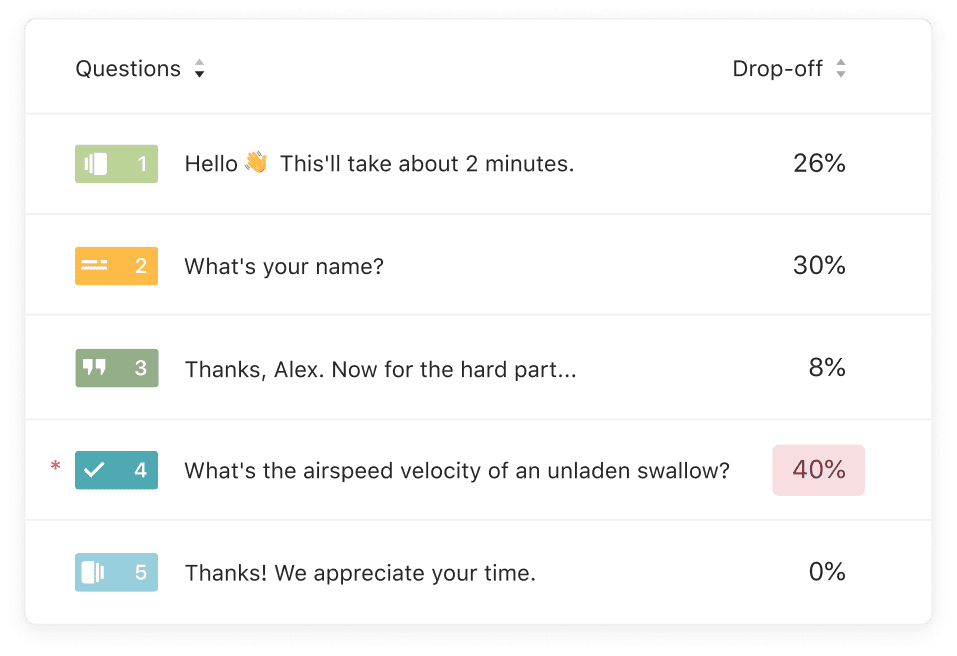
Typeform cost
Typeform’s paid plans start at $25 per month though it also features a free plan to give you a taste of their tool.
Jotform
For learning designers looking for more control over their surveys and who may also want to build simple apps to support their training programs, Jotform is a solid choice.
You can get started with a simple online quiz or survey template, though when you need more power, Jotform has you covered. You can create conditional logic, generate custom reports, process payments and even include custom widgets to speed-up your workflow. Want people who left a low feedback score to have the option to book a Calendly meeting from inside your survey? In Jotform you can do that.
Jotform definitely falls on the more complex side of learning design software, but if you have custom needs based on your business or training program, the power it offers can be well worth the effort.
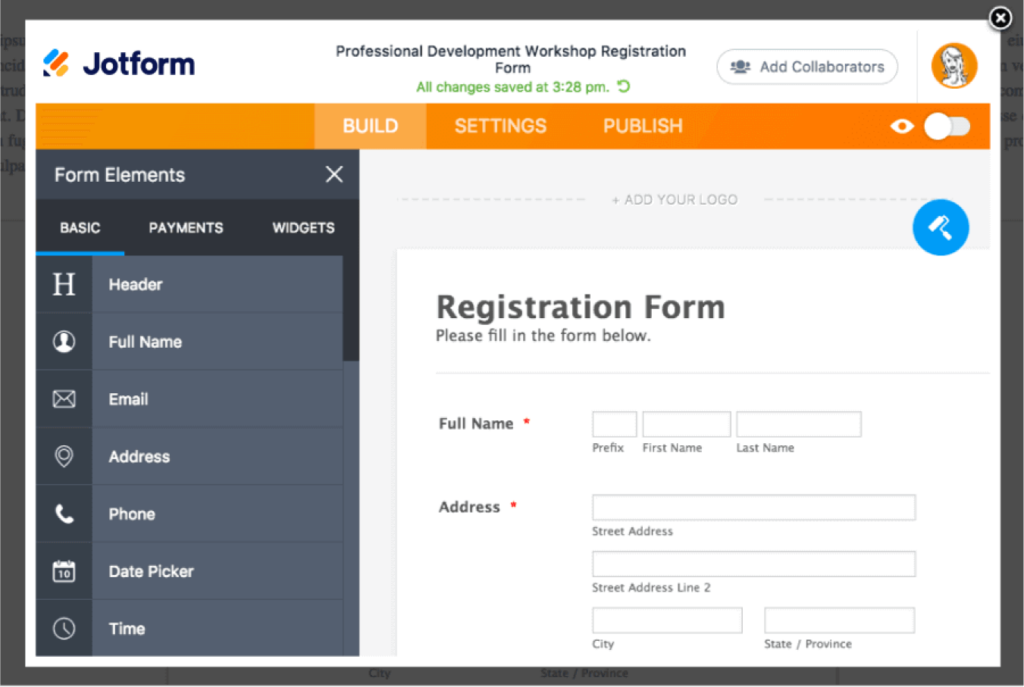
Jotform cost
Jotform has a free plan with up to 5 forms and 100 responses. Paid plans for Jotform start at $34 per month.
Google Forms
Need a free online survey tool that is easy to learn and share? Google Forms is a simple, easy-to-use survey tool that trainers can use to create surveys in minutes. Share a Google Form link in emails to participants to quickly get simple feedback though note that for more advanced data collection or embedding and reporting, paid tools might be more better suited to your needs.
While it lacks powerful features and can’t be visually customized to match your brand or company, for trainers who need a simple, free tool, Google Forms is easy to recommend.
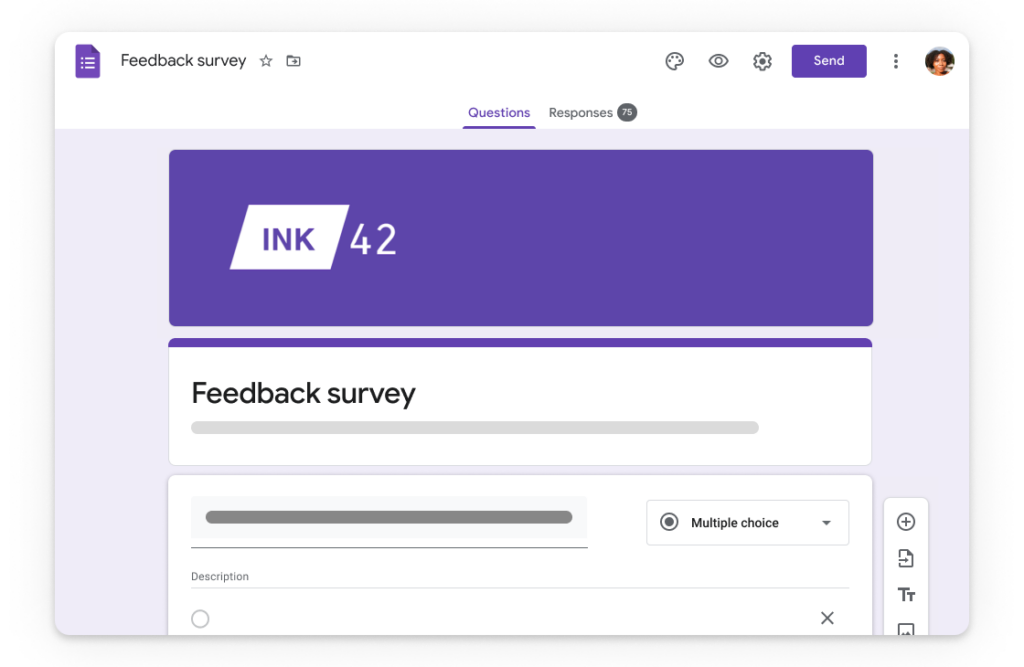
Google Forms cost
Google Forms is completely free to use!
Learning management systems (LMS)
A learning management system is a platform for hosting, managing and tracking learning programs and training content.
Typically, these tools provide a hub that allows learners to engage in self-paced courses, sign-up for instructor facilitated learning, start discussions with other learners, access supporting materials and track their progress. For instructional designers, an LMS is where your created materials are hosted and used by learners and instructors.
While one-off training sessions are unlikely to require a whole LMS to run them, for learning designers in a corporate or educational environment, an LMS is a vital part of your ongoing learning and development strategy.
TalentLMS
For SMEs setting up a learning and development program, the scale of the task can be overwhelming. Tools that are powerful but easy to use can really help your teams create change at speed and ensure you develop your team effectively.
TalentLMS has a host of features for making it easy to compile your course materials and learning flow into an effective course. You can add images, videos, tests, quizzes and more in their drag and drop builder and upload file types from your content authoring system too.
When it comes to creating learning paths as part of an ongoing L&D plan, TalentLMS has you covered too. Create personalized pathways and completion rules to help guide learners and meet your training goals. Set-up automations and track training efficacy with custom reports to help streamlining and improve your training programs.
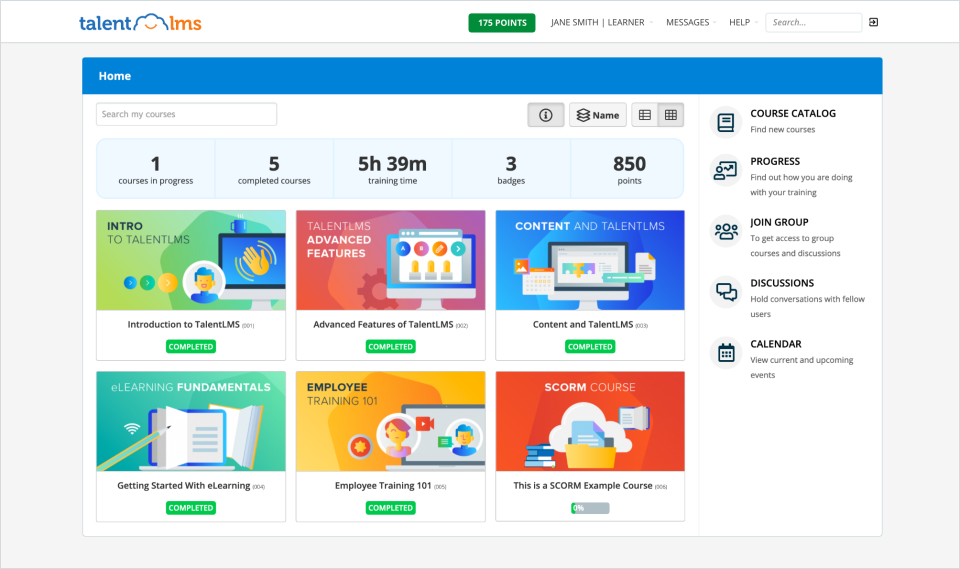
TalentLMS cost
TalentLMS starts at $ 69 /month for up to 40 users.
360Learning
360Learning is one of the most trusted names in talent development and with good reason. It hosts a whole suite of tools that can allow an instructional designer or an L&D team to run their entire program from one place.
The LMS portion of 360Learning has powerful features to automate your learning program and integrate your training with your existing HR and CRM tools. It supports SCORM imports from other tools and has features for blended learning pathways too so however your program functions, it can find a home here.
Bring in 360Learning’s AI powered content authoring and academy options and everyone from SMEs to universities can find features to help them create a culture of collaborative learning.
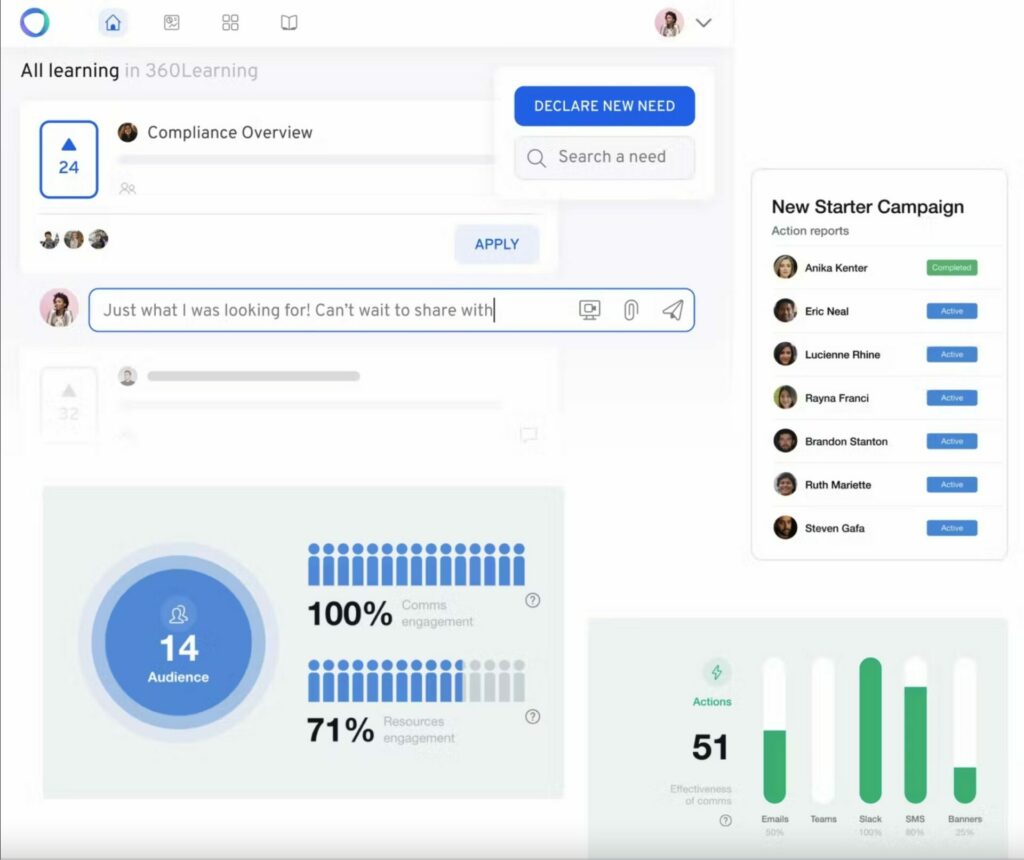
360Learning cost
360Learning’s LMS starts at $8 per user, per month. For larger companies who wish to use many of the more powerful features may need the Business plan, which has a custom quote.
Blackboard Learn
For many of us who attended higher education in the last 20 years, Blackboard has been a familiar part of our learning journeys. Blackboard Learn is an LMS that focuses on the needs to educational institutions and instructional designers operating within those systems.
As part of the Anthology product suite, institutions are able to manage everything from student enrolment, classroom engagement and course materials as well as accreditation and testing.
As a tool designed for learners of all different backgrounds and proficiency levels, Blackboard has an emphasis on creating a user-friendly learning environment that also enables instructors to deliver great experiences. For instructional designers working in education or whose materials take a more blended approach, Blackboard is a powerful option of LMS.
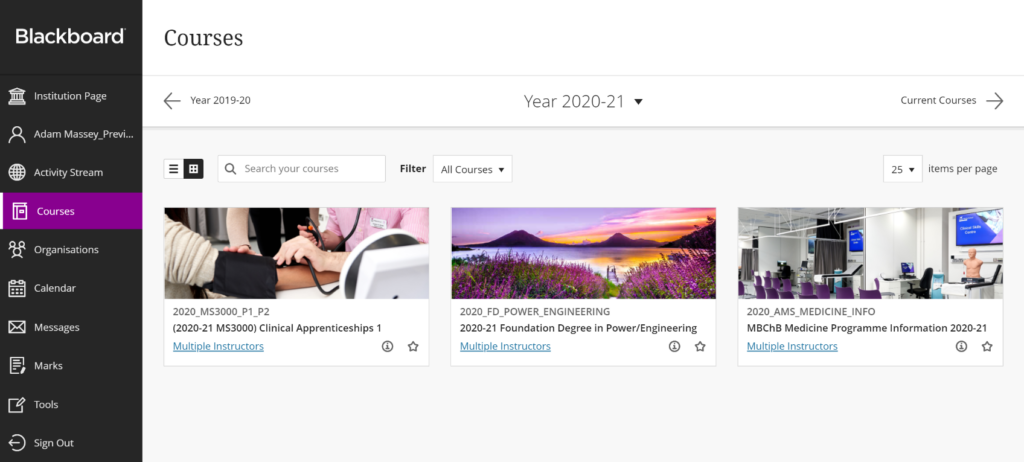
Blackboard Learn cost
Blackboard Learn has a 30-day free trial, though institutions will need to get in touch with them for a custom quote.
Presentation tools
Visual presentations and slide decks are a common way trainers and learning designers deliver training materials to participants.
Whether it’s a live session or a recording, creating an effective visual presentation can help engage learners and make it easier to understand complex concepts or large amounts of information. Here are some of our favourite presentation tools for instructional design.
PowerPoint
Microsoft PowerPoint is a slide presentation tool that is used by a large number of facilitators, trainers and learning designers. (It was heavily featured in our own State of Facilitation report). It’s an industry standard tool with everything you’d expect from a presentation tool. It’s easy to quickly build effective presentations, embed media files and have control over your slides while delivering.
You’ll also find a host of templates and AI powered assistance in the form of copilot, helping you make attractive presentations at speed. While some of its features may feel a bit old-school compared to newer competitors, you’ll find an effective tool in PowerPoint.
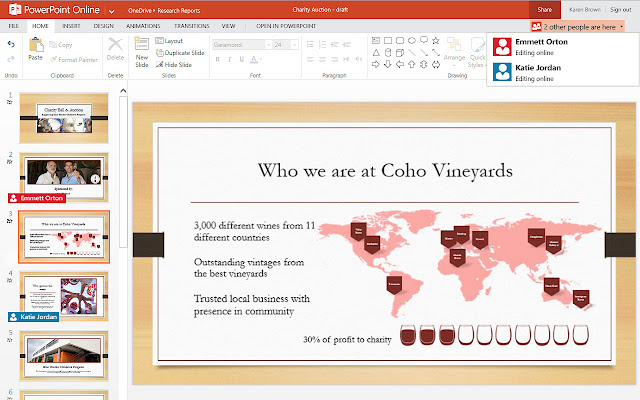
PowerPoint cost
Microsoft PowerPoint has a free plan for single users though it also comes as part of a Microsoft 365 business subscription which starts at $8.25 per user per month.
Pitch
Beautiful, easy-to-understand presentations can significantly impact how learners engage with your training content. Pitch is a powerful, easy-to-use presentation tool with an emphasis on creating engaging content in a collaboration friendly environment. Whether you’re completing slide decks with subject matter experts or hosting live training sessions where you want participants to take part on the board, Pitch has you covered.
Pitch is also very useful when creating materials for learners to browse at their own speed. You can send custom invitation links, track who’s accessed the material and easily organize comments and questions too.
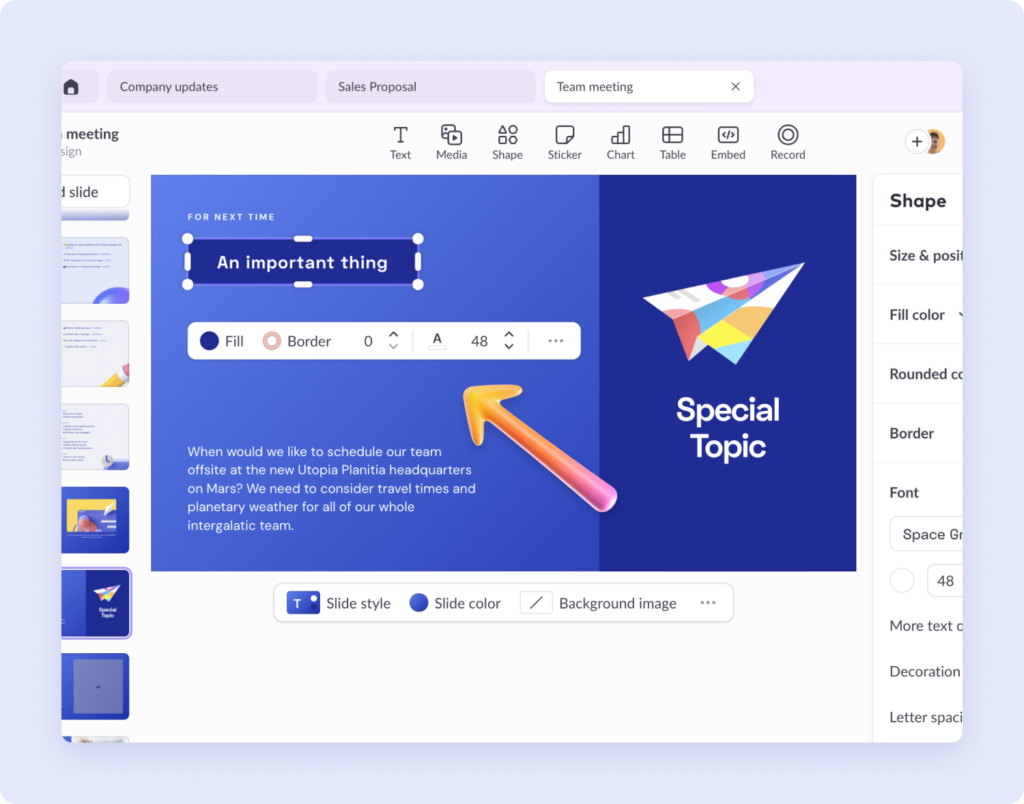
Pitch cost
Pitch has a free forever plan for teams getting started. It’s paid plans start at $20 per month.
Visme
Visme is an effective tool for creating presentations, but it can also help instructional design teams with creating other assets, such as infographics, graphs and more.
The speed at which you can build attractive presentations is a massive boon in Visme. It’s easy to just drag and drop assets from their library or use a previous presentation as a starting point. Using presentations as a background for a recording? Visme’s Presenter Studio lets you create and record presentations in one-place.
For instructional designers whose presentations form a central part of their course materials, Visme is an excellent choice. There’s no steep learning curve, it has a heap of features to help create attractive supporting materials and you can even important from PowerPoint too!
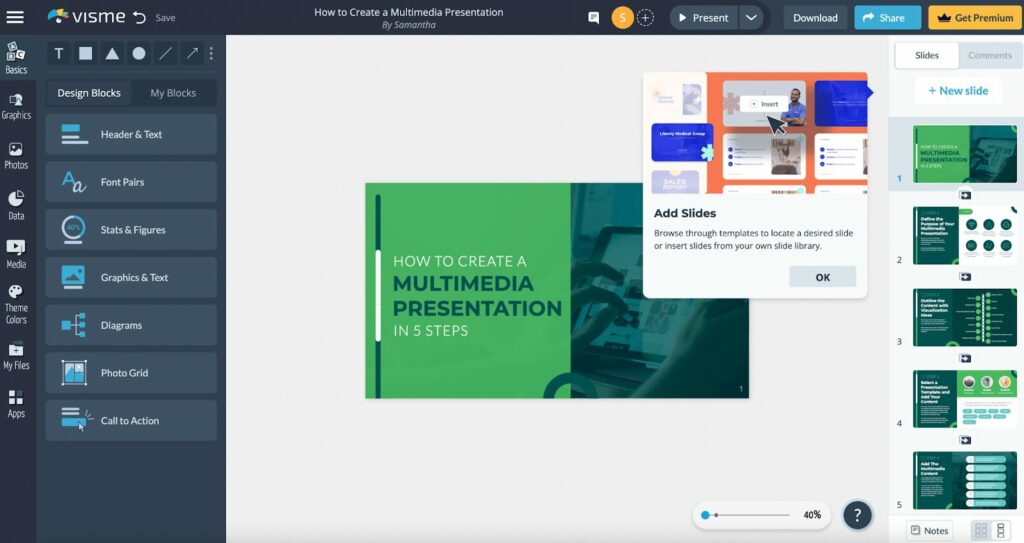
Visme cost
Visme has a free plan with unlimited projects but limited assets. Paid plans start at $12.25 per user, per month.
Graphics and infographics tools
Whatever style of instructional design is being delivered, you’ll likely need some learning design software to support your content with attractive visuals and graphics. These can range from simple graphs and breakdowns to complex illustrations, infographics and visual learning aids.
In this section, we’ll share some of our favourite instructional design software for creating or sourcing visuals and infographics.
Canva
In the past, instructional designers often needed to enlist the help of professional designers for even the most simple supporting materials. With tools like Canva, this is no longer the case.
In Canva, it’s easy to create attractive visuals and graphics to support your courses. You can easily drag and drop assets, use templates When creating highly detailed infographics, Canva can fall down and it can be tricky to micromanage every detail of a complex design. It’s a great all-rounder but dependant on your needs, you may tools that offer greater a more bespoke feature set and greater degrees of control.
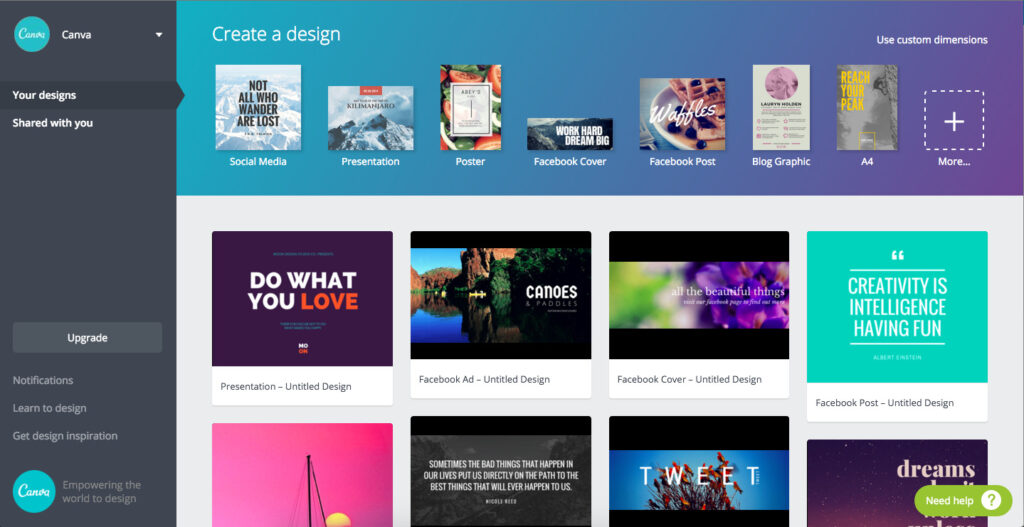
Canva cost
Canva has a free plan, though if you want to have complete access to the asset library and use some of their more powerful features, paid plans start at $11.99 per person.
Vennage
If you’re looking for learning design software that will help you create pixel perfect infographics and other graphics for your courses, Vennage is a great tool to check out. Their infographic maker is simple to use, even if you have low design skills. It’s easy to drag in different assets, graph types and data visualizations and create an attractive design quickly.
You’ll also find lots of features to support your other graphic needs: mind maps, spider diagrams and timelines are also easy to make in Vennage. For courses where you need bespoke diagrams and infographics, you’ll find everything you need here.
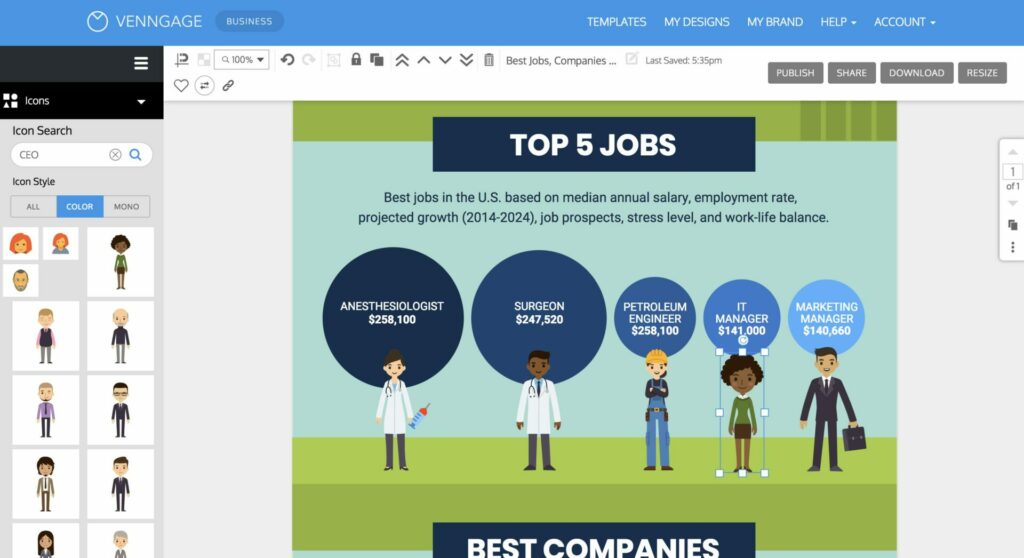
Vennage cost
Vennage has a free plan supporting up to 5 designs. Paid plans start at $10 per user, per month.
Freepik
Need stock photos and illustrations fast? FreePik is a great source of illustrations, photographs and vector graphics you can easily incorporate into your training materials. You can even find professional quality video materials.
While it’s unlikely that you’ll find everything you need to support your course here, Freepik is a great place to quickly find attractive assets to slot in alongside bespoke learning materials. You might source high-quality stock images to use as backgrounds, cover images or to simply break up longer sections of text with illustrations when you don’t want to overload learners.
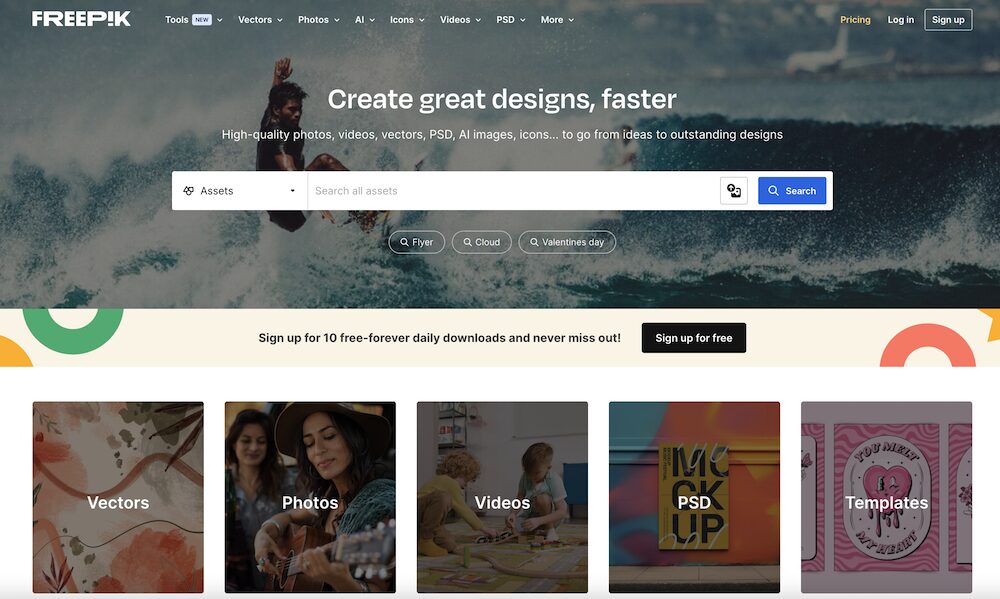
Freepik cost
Freepik allows users to download up to 10 images per day for free so long as you attribute them correctly. Paid plans with unlimited downloads and premium assets start at $12 per month.
Adobe InDesign
We’ve heard from many learning design teams who still swear by the power and control offered by Adobe InDesign. While there’s a steeper learning curve than many of the other tools on the market, InDesign is a professional level learning design tool that teams often use to create ebooks, training gudies and other supporting materials that contain graphics.
InDesign integrates well with the rest of the Adobe suite and has many powerful features for creating training materials that look especially great when printed.
Many teams will also pair InDesign will Adobe Illustrator or Canva: using InDesign to bring copy and graphics together into an attractive page layout. If your learners and students require printed learning materials and your content isn’t constantly changing, Adobe InDesign is still one of the most powerful tools on the market.
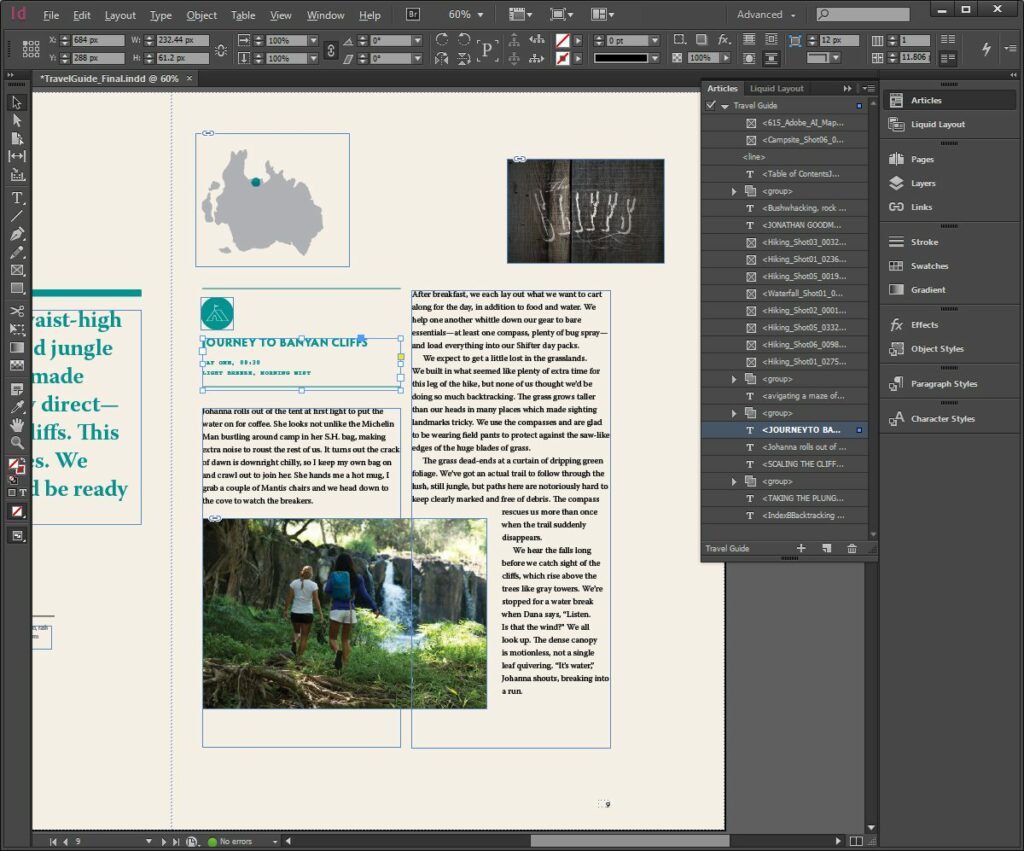
Adobe InDesign cost
Adobe InDesign’s paid plans start at $22.99/month, but they also offer significant discounts for students and educators.

Interactive learning and engagement tools
Educators and learning designers have always used games and interactive learning tools to supplement their in-person courses and training programs. In virtual and self-paced learning environments, interactivity is arguably even more important. These kinds of learning design tools help designers create opportunities to engage learners and add variation to their learning flow.
In this section, you’ll find tools that range from simple quiz creators and engagement tools to entire platforms designed to create an interactive learning environment. While many eLearning authoring tools and LMS do include plugins and tools for adding simple quizzes and interactive elements, sometimes a bespoke tool is your best bet, especially for trainers running live courses and seminars.
Kahoot
For trainers and educators creating an experitential learning environment, engaging games and simulations can be an important part of their courses and training programs.
Kahoot is a virtual engagement platform that makes it easy to create and share interactive quizzes, puzzles and more to your training sessions and courses. You have options that allow you to run live games in your virtual classroom or host self-paced games as part of on-demand learning. These games run great on desktop or mobile and on some of the higher tier plans, you can even create Kahoots directly from a PDF.
If you want to add simple and engaging quizzes to your sessions without needing to tie it into your LMS, Kahoot is a great choice of a powerful yet lightweight tool.
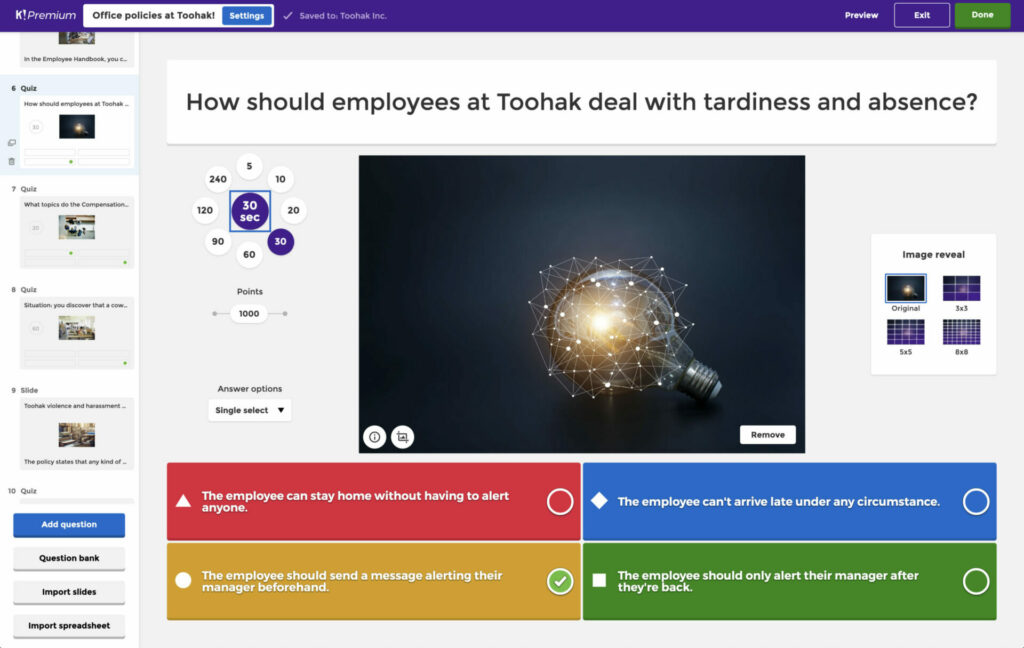
Kahoot cost
Kahoot offers various plans based on your sector and your required features. Plans start at $3.99 per month for teachers and $17per host, per month for businesses.
Trivie
Trivie is a relatively new platform for instructional designers interested in using gamification and social learning to supercharge their development programs. Trivia positions themselves as an alternative to a traditional LMS, with features such as peer-to-peer learning tools, badges and leaderboards and smart analytics to identify risks and learning opportunities.
For organizations setting up a talent development program and who want something lean, modern and potentially more engaging, Trivie is worthy of consideration. We also loved their flat approach to pricing and AI powered training suggestions that can help automate and streamline employee training flows.
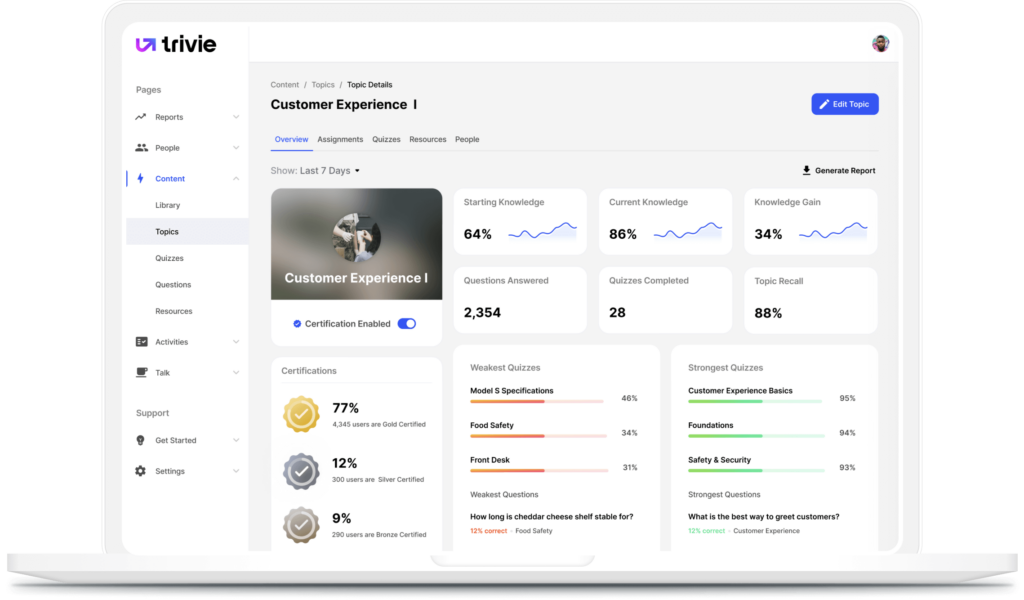
Trivie cost
Trivie has a free trial with unlimited learners and its paid plans start at $499 for 100 learners.
Go4Clic
Go4Clic is an e-learning platform designed to help instructional designers and corporate trainers create active learning environments with ease.
One of their banner features are their interactive, timed challenges, which are designed to increase engagement and participation among groups, communities and cohorts. You’ll also find powerful dashboards to help you make strategic, data-driven decisions and tools designed to streamline your workflow and deliver value to clients at speed.
For those of you with training businesses, you can also set-up payments, certificates and integrations with other tools to help streamline and empower your courses.
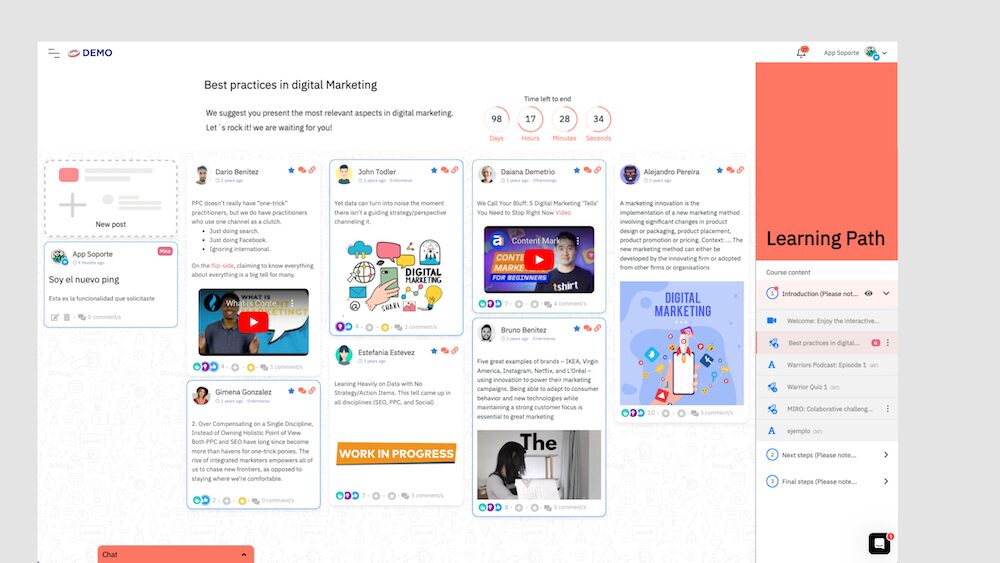
Go4Clic cost
Go4Clic offers a free trial, with paid plans starting at $39.00/month.
Menitmeter
Mentimeter is an effective engagement tool used by educators and trainers to encourage participation with live polling, surveys, games and more. You can easily create quizzes on the fly and display responses in word clouds instantly, adding an engaging and dynamic element to your live sessions. You can also create presentations, export data for use in reports and easily integrate your surveys in video tools like Zoom.
Mentimeter is also extremely popular among facilitators: it was the engagement tool most referenced by respondents to the State of Factiliation 2024 survey.
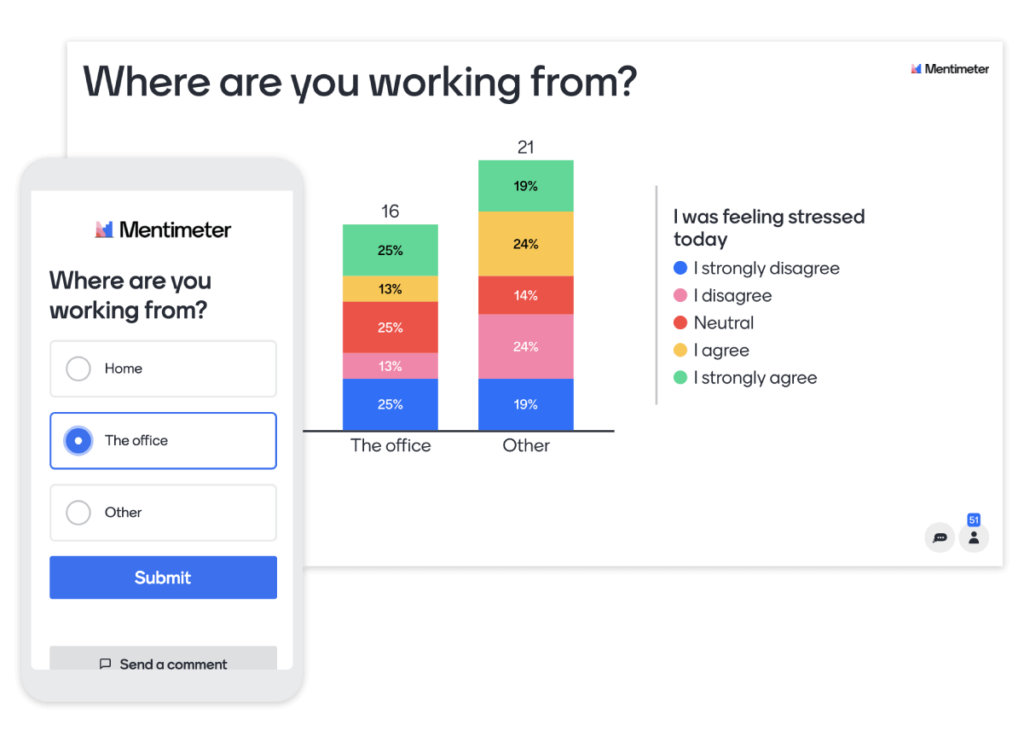
Menitmeter cost
Mentimeter has a free plan for up to 50 participants, with paid plans starting at $17.99.
Project management tools
Creating an entire learning and development program is no simple task. There are often a lot of moving parts, and a need to project manage the instructional design process from first draft through to release and evaluation.
For many designers, project management is likely to happen in a centralized company tool to allow oversight and collaboration between teams. For freelance designers and learning professionals, a more lightweight solution can often be sufficient to support your process.
Notion
Notion is a powerful tool for everything from documentation to project management. It’s even possible to host lightweight, document based training and onboarding directly in Notion. We use Notion in SessionLab as a place to collect our knowledge and manage our work. It’s easy to create custom databases, kanbans and anything else you need to manage even the most complex projects.
For organizations already invested in Notion, it’s a natural fit. If you’re looking for a new project management tool and a place to collect documentation and course materials, Notion might be the tool you’re looking for.
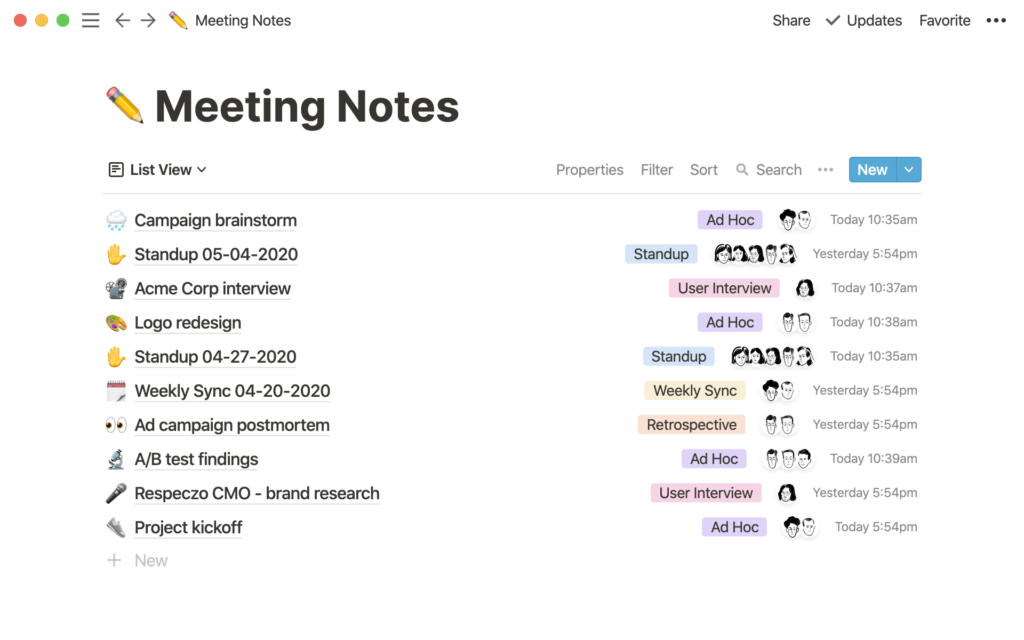
Notion cost
Notion has a free plan for individual users (great if you’re a solo learning designer!) and paid plans for teams starting at $8 per user / month.
Asana
Asana is a well-known tool in the project management world with good reason. It’s easy for teams to get started and see value quickly while also having the power to connect projects and tasks with high level goals. Managing individual tasks and responsibilities as part of a greater workflow is easy in Asana.
Asana also has helpful additional features like time tracking and automated workflow management that can make completing your learning designs faster. For organizations who want to work cross-departmentally and have a high level overview of how every project connects to long-term strategy, Asana is a great fit.
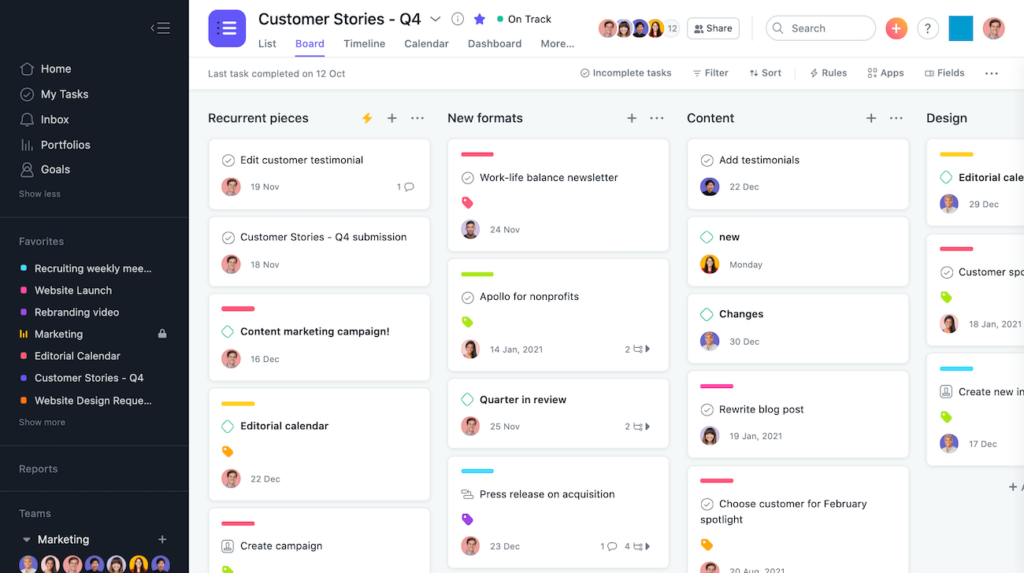
Asana cost
Asana has a free individual plan to help you get started out. Their paid plans begin at $10.99 per user per month.
Trello
For project managers and instructional designers who like to think in boards, cards and timelines, Trello is an effective and easy-to-use project management tool.
They focus on providing many different views for your data and projects, so you can present the information you need in the way that best allows you to organize and complete tasks. You can add labels to let collaborators see priority or which part of the instructional design process a task is in.
Trello can also be used as a resource hub, which can be great for small teams collecting resources for a course or learning program. While Trello offers lots of power, it’s also very easy to get started and it functions perfectly for small teams.
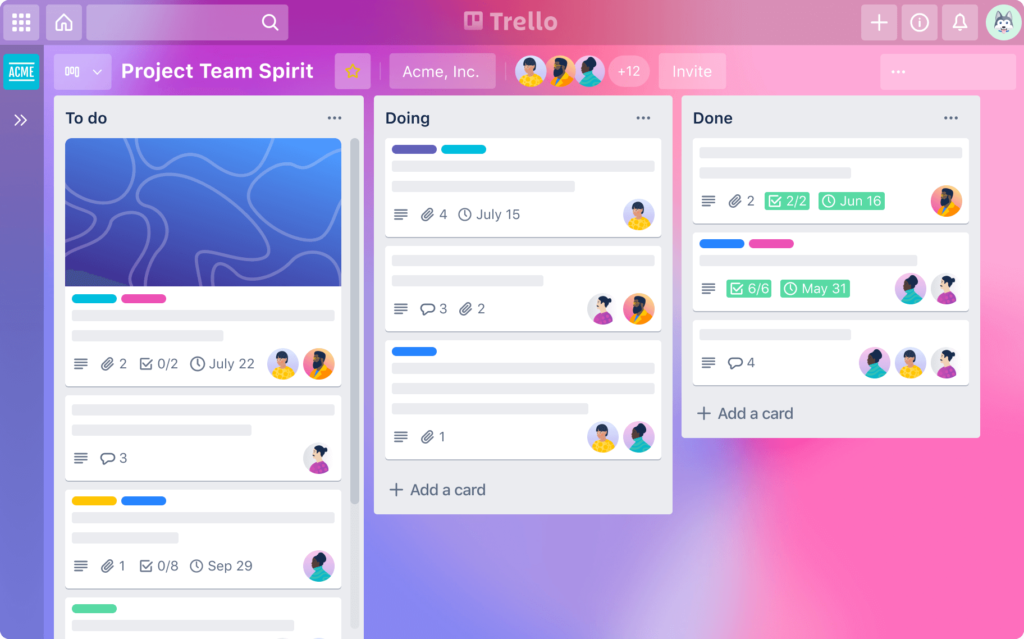
Trello cost
Trello has a free plan that’s great for small projects. Trello paid plans start at $5 per month.
Online course platforms
If you’re an instructional designer who wants to create custom elearning courses and sell them to the public or your existing community, you might also want to make use of an online course platform or marketplace.
Instructional design software in this category falls into two categories: platforms that help you build and publish interactive courses you can host on your website and marketplaces where you create online courses to share with the existing audience on the platform.
Both sets of instruction design software tools have features design to help you assemble your elearning courses, make them engaging and share them with your audience. If you’re an instructional designer creating corporate training, these tools can be a great alternative to a whole LMS. In effect, you sacrifice some of the control and SCORM compatibility for the ease of authoring and hosting an entire course in one-place.
If you’re a freelance learning designer looking to create responsive courses and bolster your training business, these tools can streamline the whole process for you and also help you find an audience.
Teachable
Teachable offers a great platform for creating, hosting and selling interactive courses and elearning material. You’re able to create online courses, run a coaching business, offer digital downloads and create a whole school with many different learning opportunities.
In Teachable, it’s easy to create courses and manage payments and memberships from one place. For a freelance instructional designer or coach who wants to create and sell material or develop elearning courses on behalf of a client who may want to easily host them, Teachable is a solid option.
For L&D teams creating training programs for their organization, Teachable may lack some features of other instructional design software for you though it would still support this use case. Give it a try if you’re looking for a solution that may include creating an academy or education setting feel within your program.
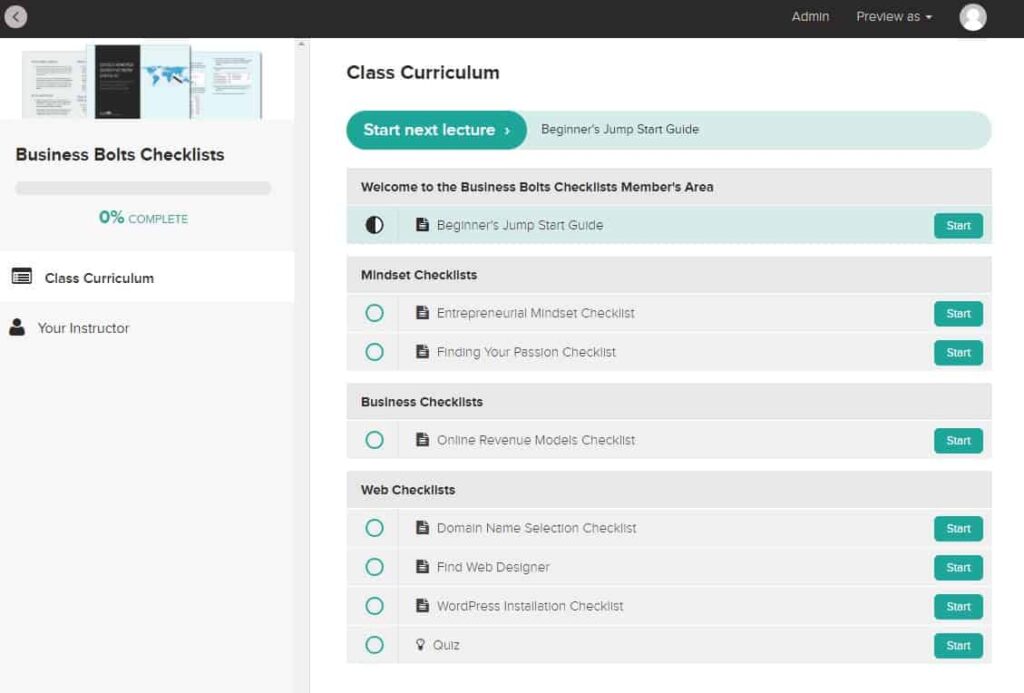
Teachable cost
Teachable starts at $39 per month with a free plan to get you started.
LearnWorlds
Many instructional design software tools share common elements, even while they may specialize in a few areas. LearnWorlds is a complete elearning platform that does lots of thing wells. It’s easy to create interactive training videos, bring them together in a community learning space or school and share it with your employees, customers or community.
LearnWorlds is highly flexible, SCORM compliant, and if you’re looking for instructional design software that is feature complete and can also allow you to serve both internal and external training needs, LearnWorlds is worthy of your attention. It has advanced features to help you throughout the process and may even allow you to drop separate elearning authoring tools in favour of using a single platform.
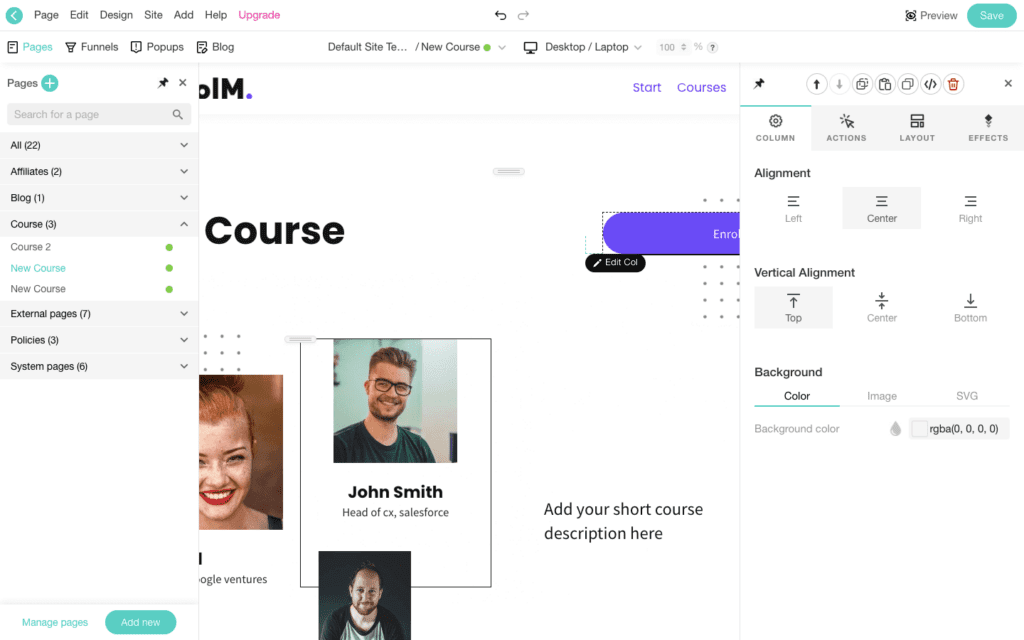
LearnWorlds cost
LearnWorlds pricing plans start at $24 per month, though note this includes transaction fees for course sales. You may need to upgrade to the higher tier plans, particular if you need instructional design software to support your organization internally.
Mighty
One trend in elearning is the rise of community learning spaces and of elearning courses that feature community or cohort-based learning at the heart of their offering.
Instructional design software like Mighty (Formerly known as Mighty Networks) is designed to create a thriving community space that can support elearning courses, membership plans and other training material in one social space. You’ll find features to help you create your training courses, host live sessions and cohort networks and even build your own mobile community app, all without coding knowledge and a small learning curve.
Mighty isn’t going to be the right choice for every instructional designer. Internal learning teams may go in a more traditional route, but if you’re interested in exploring coursed-based communities, these platforms can offer a single place. Just note that some of the features you might expect from popular instructional design software might be more lightweight than in a bespoke learning management system or more robust authoring tool.
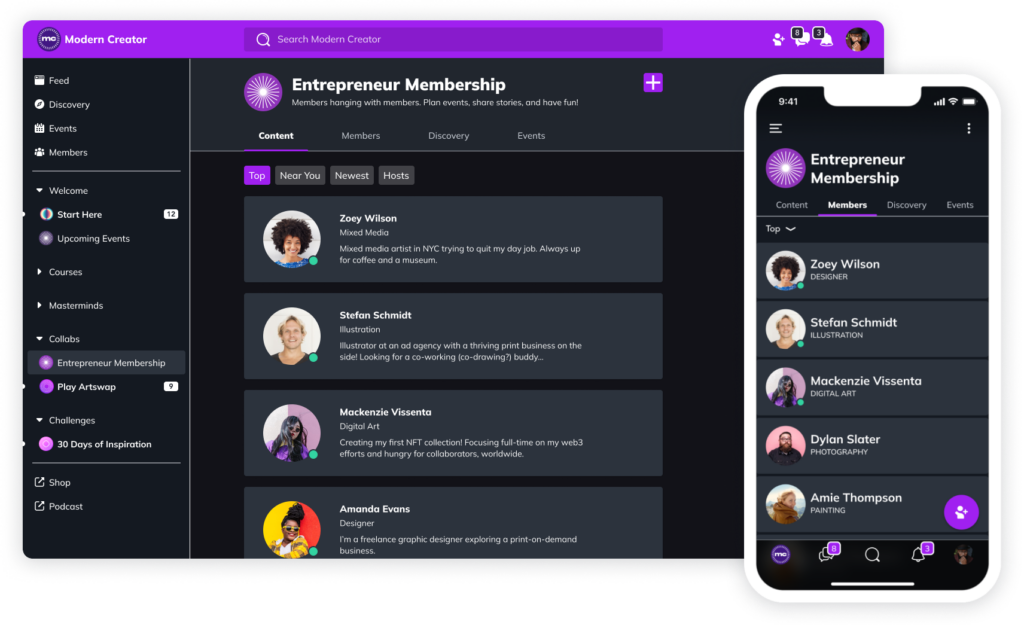
Mighty cost
Mighty paid plans start at $33/mo when paid annually.
Digital Adoption Platforms
For many organizations, training often revolves around the adoption of new tools and systems. Digital adoption platforms are expressly designed to help organizations onboard new team members, run software simulations and help employees access training while using a specific tool.
Often, the best instructional design software is that tool that best helps you achieve your training goals and create an ideal environment for your learners. A digital adoption platform that allows them to complete training while inside the tool they’ll be using can often be more effective than any interactive videos or purely written content.
Whatfix
Instructional design is often at the heart of creating and rolling out impactful organizational change. When the changes your organization is implementing revolves around new technology, better onboarding or in-app training, a bespoke tool combined with effective instructional design is often the best approach.
For in-app learning, Whatfix is among the best instructional design software on the market. Not ony does it help you build content effectively, but Whatfix’s digital adoption platform allows you to analyze the need for training and deliver contextual in-app support to your teams when needed.
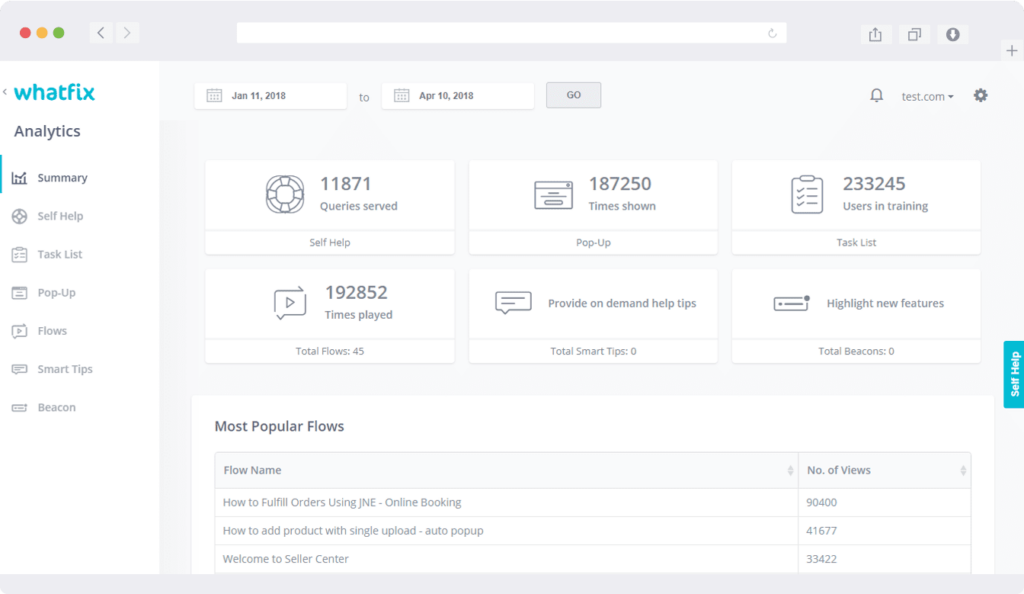
Whatfix cost
Custom quote.
Pendo
Pendo is instructional design software designed to help training teams create in-app onboarding materials, on-demand support and also gain insights into how employees are using company software. Any training material needs to be developed with the end user and their needs in mind. With Pendo, learning designers are able to gain insights into employee needs and deploy in-app learning in the same place.
The best instructional design software can be vital for teams aiming to save time, streamline workflows and get data to make informed decisions about training materials. Whether you’re giving development teams advice within a production environment or adding sales training on top of your CRM, Pendo can offer a lot of value.
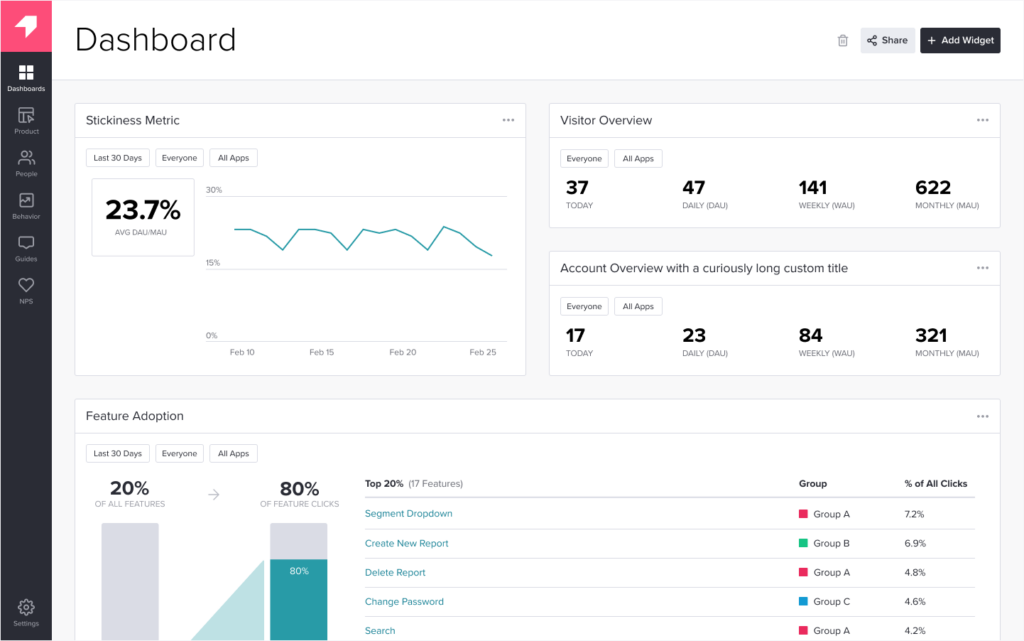
Pendo cost
Pendo has a free trial that allows teams to test the tool with up to 500 monthly users. Paid plans require a custom quote.
Curriculum design tools
For instructional designers working on instructor-led training programs, designing the agenda or curriculum for your program is a vital part of the process.
In curriculum design software, you’ll typically organize your curriculum into a structured flow, include key timings in the form of a run-sheet, lesson plan or training agenda and then include your supporting materials. On top of that, you’ll also need to design an engaging learning flow that satisfies the needs of your project and make it easy for trainers to deliver your curriculum.
Here are some great tools you can use for curriculum design and management.
SessionLab for curriculum design
Here we are again! While we’re not trying to blow our own trumpet, we’ve built SessionLab to be an effective and powerful training design tool, whether you’re designing online courses or in-person training – and we really believe in it!
When designing a curriculum, SessionLab supports you with simple yet powerful planning tools. Quickly create your curriculum flow by dragging and dropping blocks into place. Colour-code your activities by interaction type so you can easily create a balanced learning experience.
Stay in control of timing. Set the timing of each activity and instantly see the duration of your full training module. When you need to make changes, SessionLab automatically calculates your timing so you can ensure your trainers and content authors can create and deliver content with confidence.
Creating a multi-day training session or cohort based program? Quickly duplicate days, move activities between modules and overview a complex training program in one-screen.
Support your trainers by exporting your agenda with full instructions, a full breakdown of timing and support materials in the format that works best for you.
You can also organize your entire organization’s training materials in one place. Use folders and tags to keep everything organized and never lose a curriculum design again. Create templates to save time and optimize your learning organization.
Want to learn more? See an example weeklong train-the-trainer program template to see how you might structure a multi-day curriculum in SessionLab.
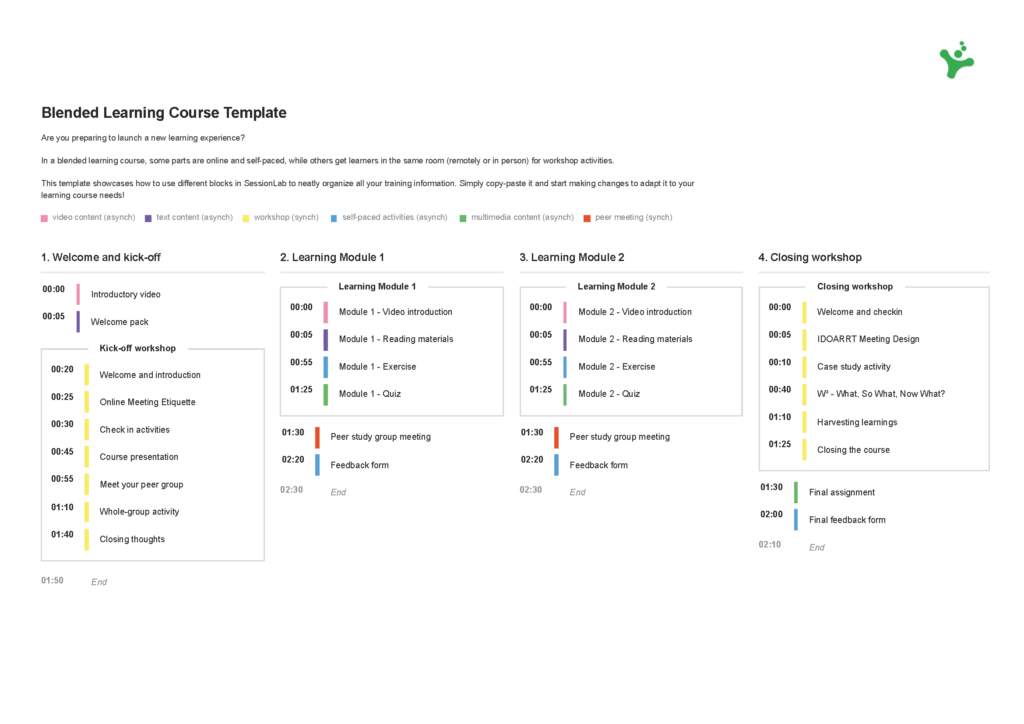
SessionLab pricing
You can get started in SessionLab for free! Paid plans that include unlimited sessions, real-time collaboration and a knowledge base of your best content for reuse starting at $15 per month.
Google Sheets
For some instructional designers who focus on instructor-led training, planning a learning flow in a spreadsheet is still an effective way to structure their course material. What Google Sheets lacks in features it makes up for in accessibility. Most folks know how to use a spreadsheet, and being able to quickly structure your entire learning flow by entering text and filling cells has its advantages.
That said, as soon as you want to add timing calculations, materials and collaborate with subject matter experts, the limitations of such a tool become apparent.
For folks just starting out or who prefer to quickly sketch out a learning flow, Sheets is a great way to get started, though it lacks many of the time-saving features of dedicated instructional design tools.
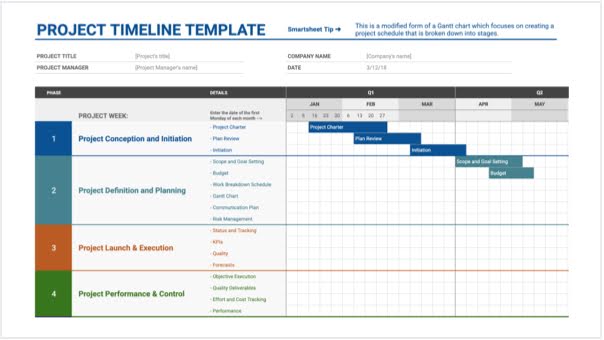
Google Sheets cost
Google Sheets is free!
MindMeister
For visual thinkers, mind mapping tools can be a useful addition to their collection of instructional design software tools. Tools like this can be an effective way to create a first outline of your instructional design, allowing you to cluster ideas, link them together and design a learning flow you can then refine into a complete design.
MindMeister is a great choice of lightweight instructional design tool that can support the first draft and learning design part of the process. You can also build curriculum maps and otherwise structure the core concepts of your course or training program.
While some folks prefer pen and paper or a tool like SessionLab that allows you to easily go from first idea all the way through to a completed training design with timings and content attached, you might find room for a mind mapping tool in your stack.
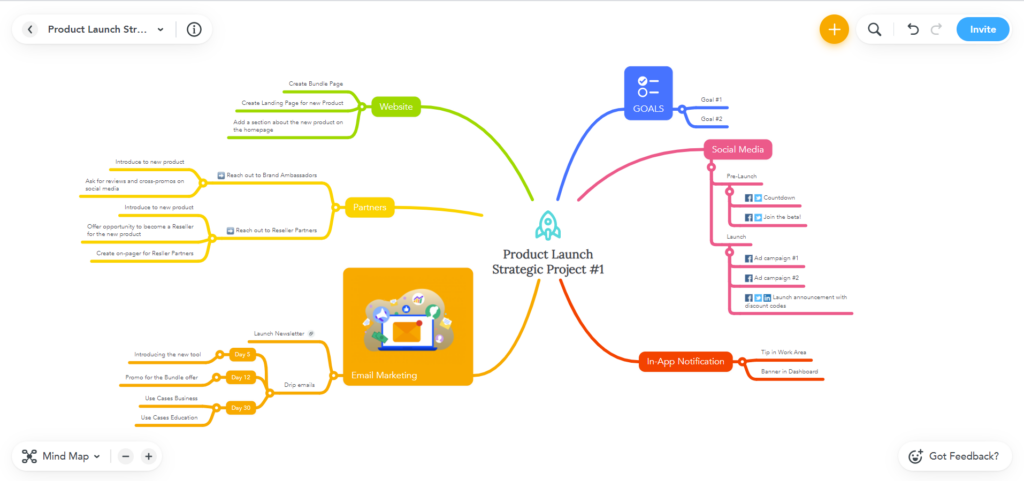
MindMeister cost
MindMeister‘s paid plans start at $4.99 per month.
Conclusion
Instructional design is an art of balancing trainer needs and organizational goals with an engaging learning flow.
With the right instructional design software, designers and trainers can be empowered to design impactful programs, support their process and deliver exceptional learning to their teams.
We hope this guide to popular instructional design software has given you an insight into how tools can help you streamline your workflow and create impactful training materials. Is there a tool you use that’s missing from this list? Let us know below!
Designing instructor-led training? Read this guide to see a proven step-by-step process for creating an effective training session plan. Ready to start designing your learning flow? Explore an example training agenda template built in SessionLab and adjust it to your needs.
Creating an eLearning storyboard for your online course? See this example of an eLearning module built in SessionLab or explore how to create a storyboard from start to finish in this guide to storyboarding.
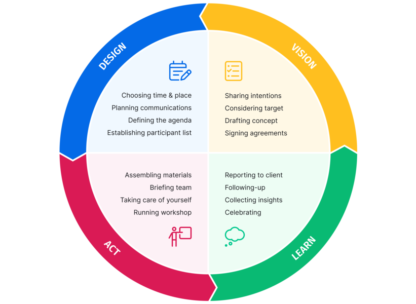


Leave a Comment